Healthcare - Nursing Professional's Roles
VerifiedAdded on 2022/08/16
|18
|5717
|12
AI Summary
Contribute Materials
Your contribution can guide someone’s learning journey. Share your
documents today.
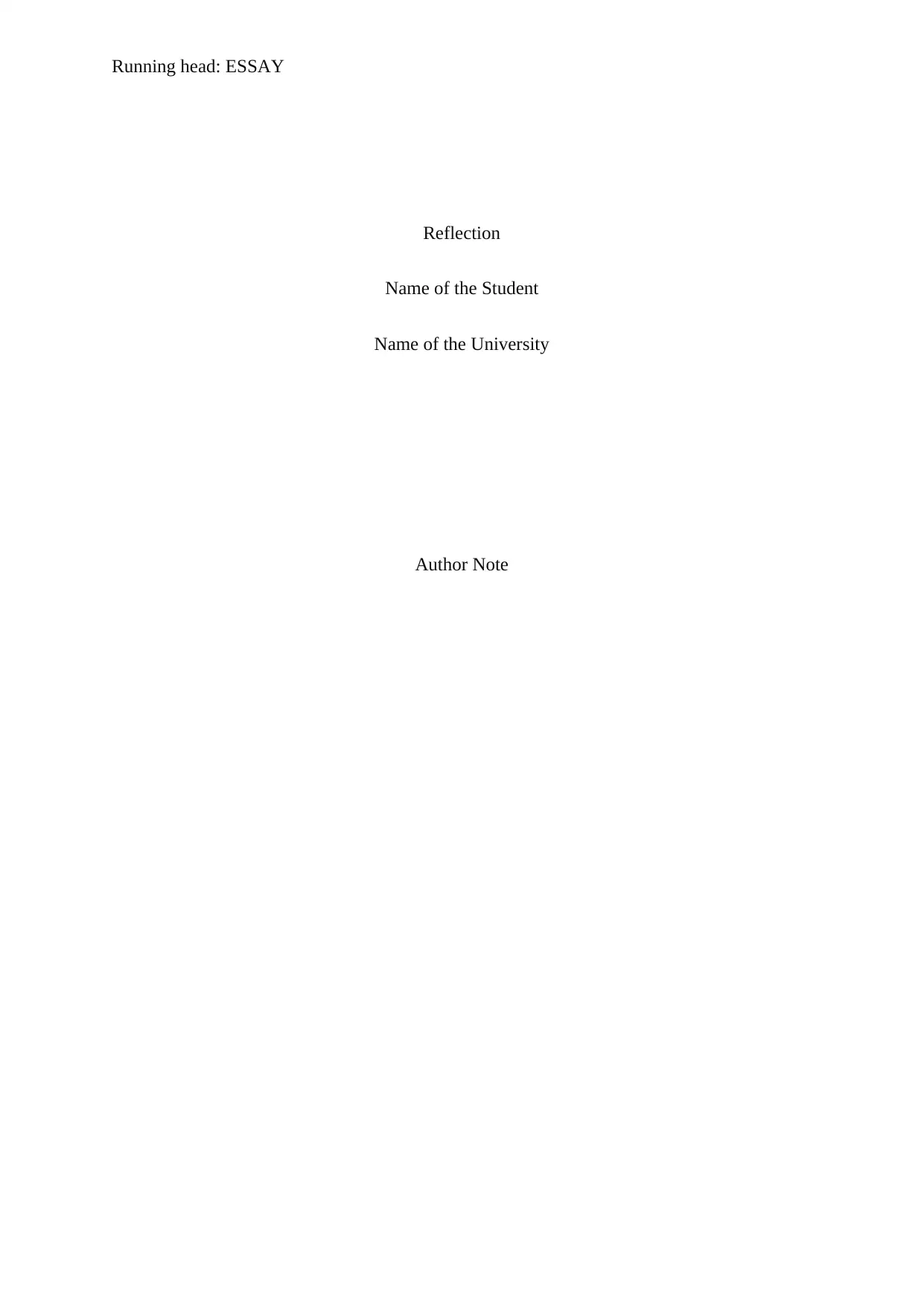
Running head: ESSAY
Reflection
Name of the Student
Name of the University
Author Note
Reflection
Name of the Student
Name of the University
Author Note
Secure Best Marks with AI Grader
Need help grading? Try our AI Grader for instant feedback on your assignments.
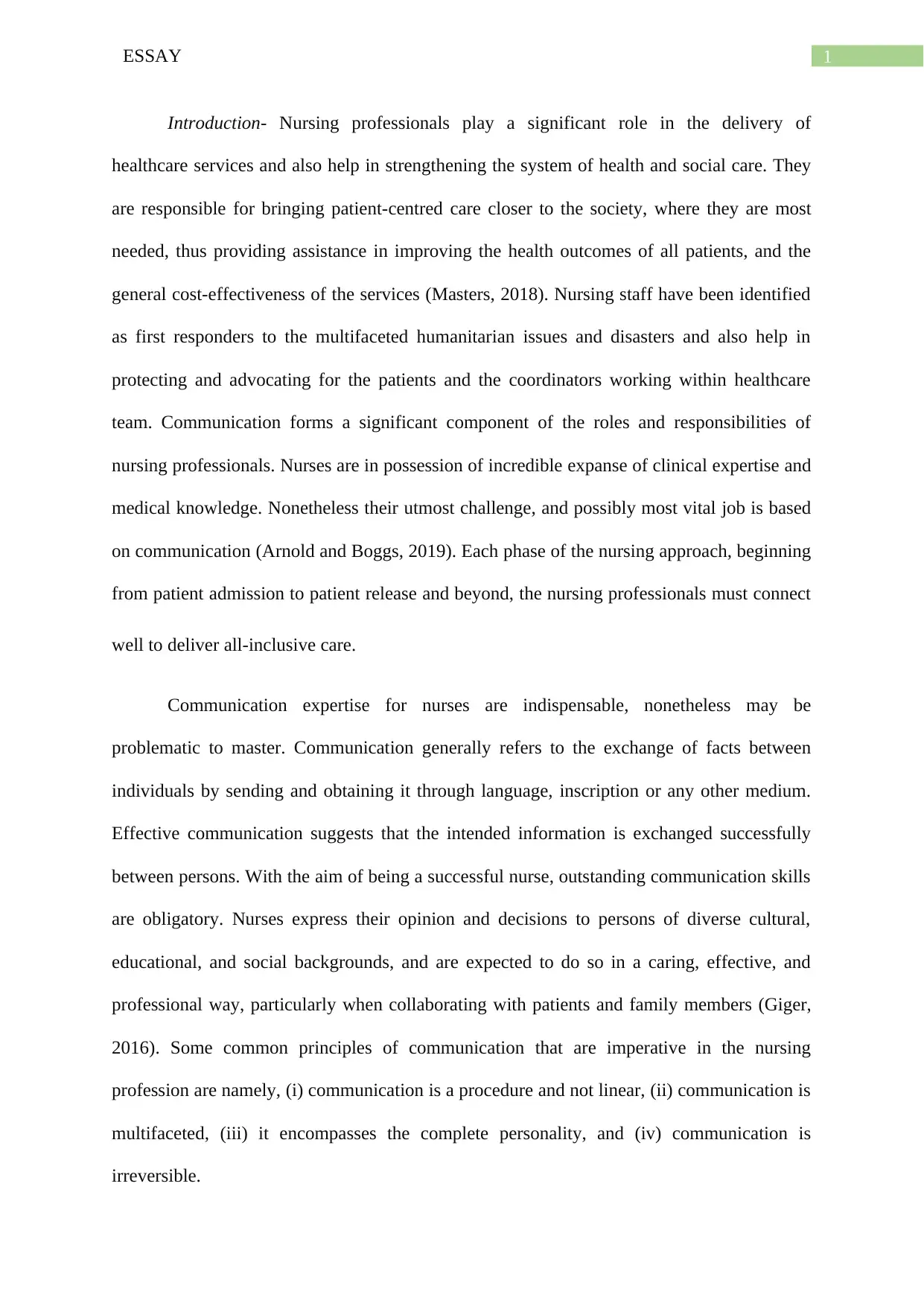
1ESSAY
Introduction- Nursing professionals play a significant role in the delivery of
healthcare services and also help in strengthening the system of health and social care. They
are responsible for bringing patient-centred care closer to the society, where they are most
needed, thus providing assistance in improving the health outcomes of all patients, and the
general cost-effectiveness of the services (Masters, 2018). Nursing staff have been identified
as first responders to the multifaceted humanitarian issues and disasters and also help in
protecting and advocating for the patients and the coordinators working within healthcare
team. Communication forms a significant component of the roles and responsibilities of
nursing professionals. Nurses are in possession of incredible expanse of clinical expertise and
medical knowledge. Nonetheless their utmost challenge, and possibly most vital job is based
on communication (Arnold and Boggs, 2019). Each phase of the nursing approach, beginning
from patient admission to patient release and beyond, the nursing professionals must connect
well to deliver all-inclusive care.
Communication expertise for nurses are indispensable, nonetheless may be
problematic to master. Communication generally refers to the exchange of facts between
individuals by sending and obtaining it through language, inscription or any other medium.
Effective communication suggests that the intended information is exchanged successfully
between persons. With the aim of being a successful nurse, outstanding communication skills
are obligatory. Nurses express their opinion and decisions to persons of diverse cultural,
educational, and social backgrounds, and are expected to do so in a caring, effective, and
professional way, particularly when collaborating with patients and family members (Giger,
2016). Some common principles of communication that are imperative in the nursing
profession are namely, (i) communication is a procedure and not linear, (ii) communication is
multifaceted, (iii) it encompasses the complete personality, and (iv) communication is
irreversible.
Introduction- Nursing professionals play a significant role in the delivery of
healthcare services and also help in strengthening the system of health and social care. They
are responsible for bringing patient-centred care closer to the society, where they are most
needed, thus providing assistance in improving the health outcomes of all patients, and the
general cost-effectiveness of the services (Masters, 2018). Nursing staff have been identified
as first responders to the multifaceted humanitarian issues and disasters and also help in
protecting and advocating for the patients and the coordinators working within healthcare
team. Communication forms a significant component of the roles and responsibilities of
nursing professionals. Nurses are in possession of incredible expanse of clinical expertise and
medical knowledge. Nonetheless their utmost challenge, and possibly most vital job is based
on communication (Arnold and Boggs, 2019). Each phase of the nursing approach, beginning
from patient admission to patient release and beyond, the nursing professionals must connect
well to deliver all-inclusive care.
Communication expertise for nurses are indispensable, nonetheless may be
problematic to master. Communication generally refers to the exchange of facts between
individuals by sending and obtaining it through language, inscription or any other medium.
Effective communication suggests that the intended information is exchanged successfully
between persons. With the aim of being a successful nurse, outstanding communication skills
are obligatory. Nurses express their opinion and decisions to persons of diverse cultural,
educational, and social backgrounds, and are expected to do so in a caring, effective, and
professional way, particularly when collaborating with patients and family members (Giger,
2016). Some common principles of communication that are imperative in the nursing
profession are namely, (i) communication is a procedure and not linear, (ii) communication is
multifaceted, (iii) it encompasses the complete personality, and (iv) communication is
irreversible.
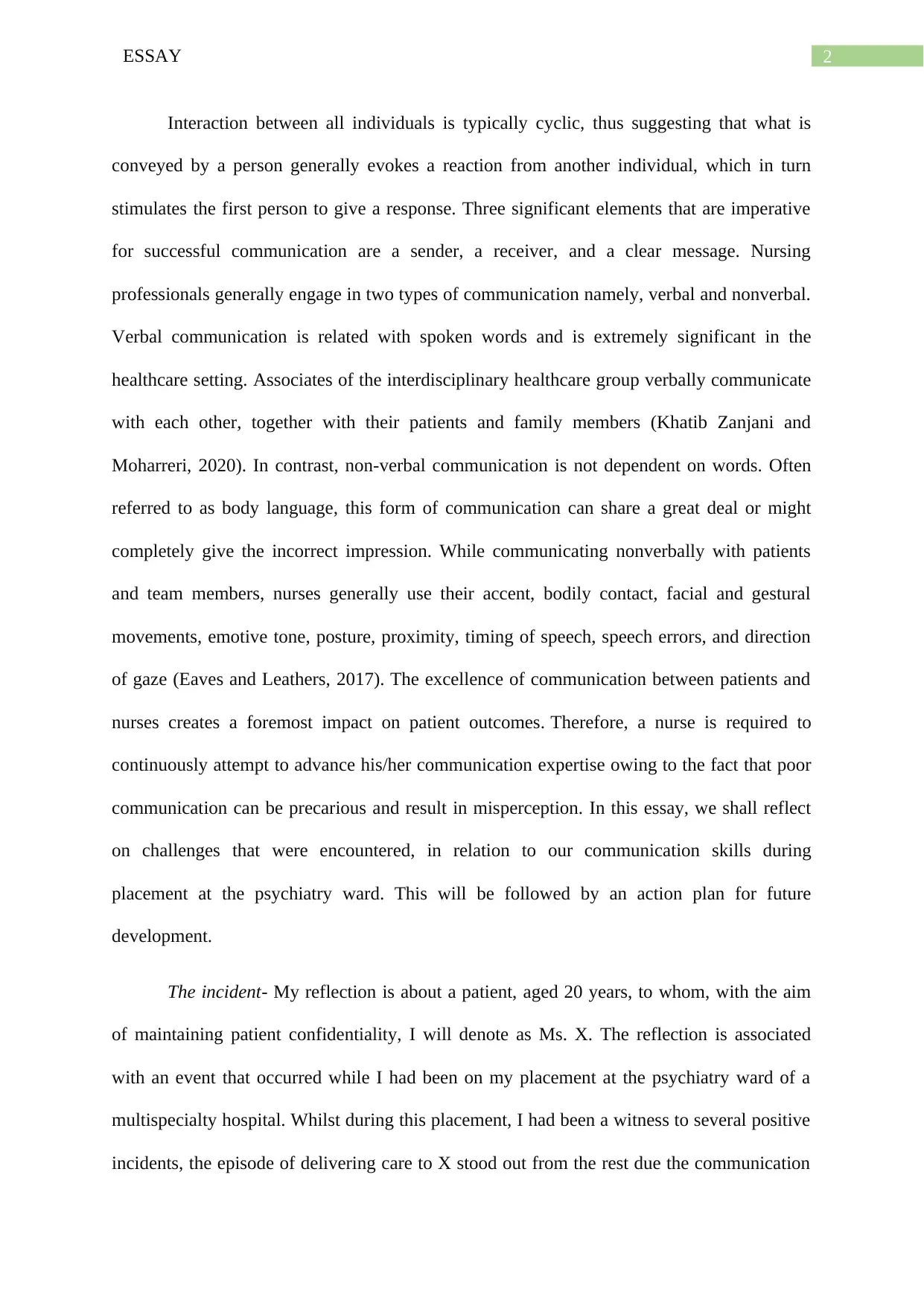
2ESSAY
Interaction between all individuals is typically cyclic, thus suggesting that what is
conveyed by a person generally evokes a reaction from another individual, which in turn
stimulates the first person to give a response. Three significant elements that are imperative
for successful communication are a sender, a receiver, and a clear message. Nursing
professionals generally engage in two types of communication namely, verbal and nonverbal.
Verbal communication is related with spoken words and is extremely significant in the
healthcare setting. Associates of the interdisciplinary healthcare group verbally communicate
with each other, together with their patients and family members (Khatib Zanjani and
Moharreri, 2020). In contrast, non-verbal communication is not dependent on words. Often
referred to as body language, this form of communication can share a great deal or might
completely give the incorrect impression. While communicating nonverbally with patients
and team members, nurses generally use their accent, bodily contact, facial and gestural
movements, emotive tone, posture, proximity, timing of speech, speech errors, and direction
of gaze (Eaves and Leathers, 2017). The excellence of communication between patients and
nurses creates a foremost impact on patient outcomes. Therefore, a nurse is required to
continuously attempt to advance his/her communication expertise owing to the fact that poor
communication can be precarious and result in misperception. In this essay, we shall reflect
on challenges that were encountered, in relation to our communication skills during
placement at the psychiatry ward. This will be followed by an action plan for future
development.
The incident- My reflection is about a patient, aged 20 years, to whom, with the aim
of maintaining patient confidentiality, I will denote as Ms. X. The reflection is associated
with an event that occurred while I had been on my placement at the psychiatry ward of a
multispecialty hospital. Whilst during this placement, I had been a witness to several positive
incidents, the episode of delivering care to X stood out from the rest due the communication
Interaction between all individuals is typically cyclic, thus suggesting that what is
conveyed by a person generally evokes a reaction from another individual, which in turn
stimulates the first person to give a response. Three significant elements that are imperative
for successful communication are a sender, a receiver, and a clear message. Nursing
professionals generally engage in two types of communication namely, verbal and nonverbal.
Verbal communication is related with spoken words and is extremely significant in the
healthcare setting. Associates of the interdisciplinary healthcare group verbally communicate
with each other, together with their patients and family members (Khatib Zanjani and
Moharreri, 2020). In contrast, non-verbal communication is not dependent on words. Often
referred to as body language, this form of communication can share a great deal or might
completely give the incorrect impression. While communicating nonverbally with patients
and team members, nurses generally use their accent, bodily contact, facial and gestural
movements, emotive tone, posture, proximity, timing of speech, speech errors, and direction
of gaze (Eaves and Leathers, 2017). The excellence of communication between patients and
nurses creates a foremost impact on patient outcomes. Therefore, a nurse is required to
continuously attempt to advance his/her communication expertise owing to the fact that poor
communication can be precarious and result in misperception. In this essay, we shall reflect
on challenges that were encountered, in relation to our communication skills during
placement at the psychiatry ward. This will be followed by an action plan for future
development.
The incident- My reflection is about a patient, aged 20 years, to whom, with the aim
of maintaining patient confidentiality, I will denote as Ms. X. The reflection is associated
with an event that occurred while I had been on my placement at the psychiatry ward of a
multispecialty hospital. Whilst during this placement, I had been a witness to several positive
incidents, the episode of delivering care to X stood out from the rest due the communication
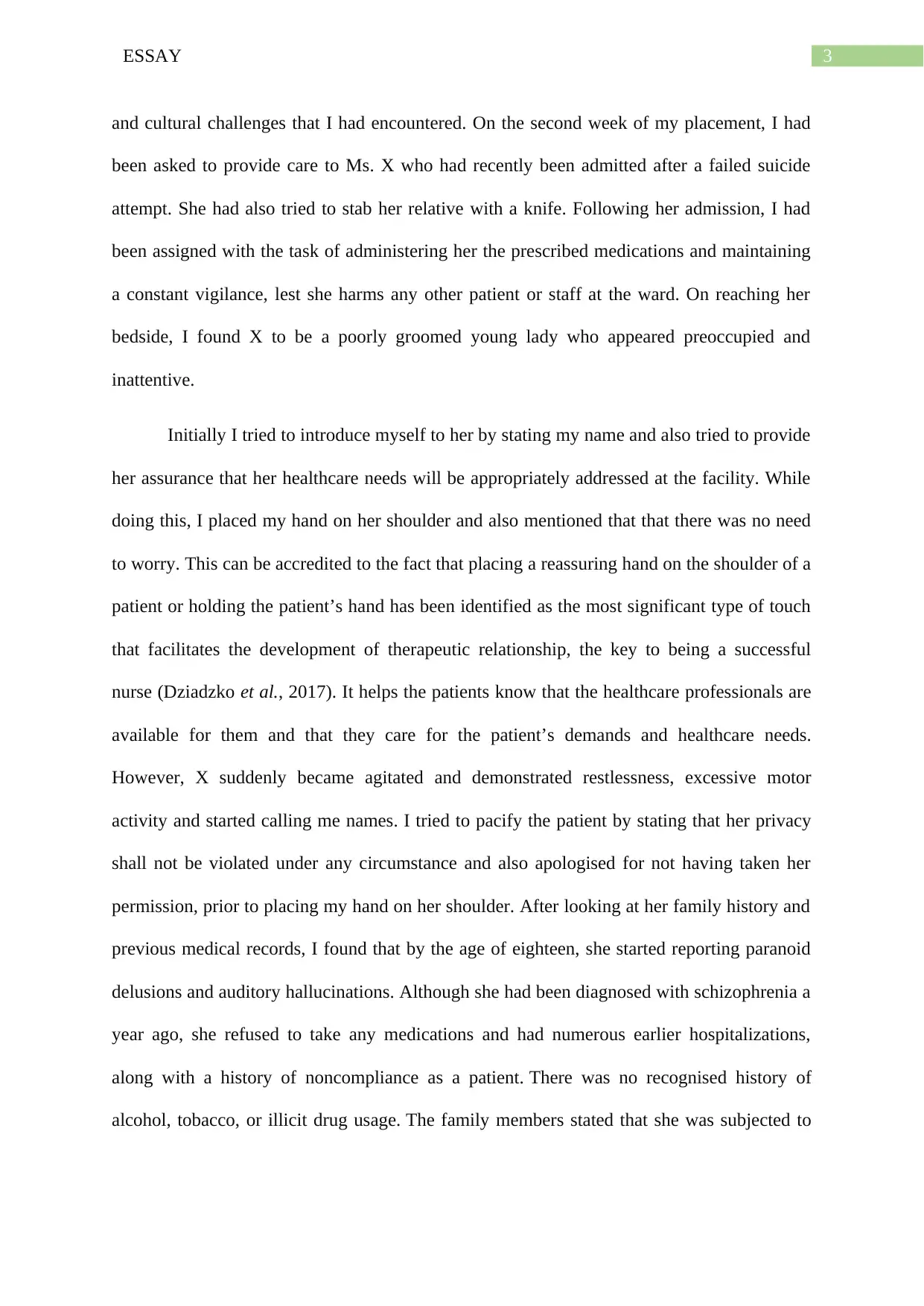
3ESSAY
and cultural challenges that I had encountered. On the second week of my placement, I had
been asked to provide care to Ms. X who had recently been admitted after a failed suicide
attempt. She had also tried to stab her relative with a knife. Following her admission, I had
been assigned with the task of administering her the prescribed medications and maintaining
a constant vigilance, lest she harms any other patient or staff at the ward. On reaching her
bedside, I found X to be a poorly groomed young lady who appeared preoccupied and
inattentive.
Initially I tried to introduce myself to her by stating my name and also tried to provide
her assurance that her healthcare needs will be appropriately addressed at the facility. While
doing this, I placed my hand on her shoulder and also mentioned that that there was no need
to worry. This can be accredited to the fact that placing a reassuring hand on the shoulder of a
patient or holding the patient’s hand has been identified as the most significant type of touch
that facilitates the development of therapeutic relationship, the key to being a successful
nurse (Dziadzko et al., 2017). It helps the patients know that the healthcare professionals are
available for them and that they care for the patient’s demands and healthcare needs.
However, X suddenly became agitated and demonstrated restlessness, excessive motor
activity and started calling me names. I tried to pacify the patient by stating that her privacy
shall not be violated under any circumstance and also apologised for not having taken her
permission, prior to placing my hand on her shoulder. After looking at her family history and
previous medical records, I found that by the age of eighteen, she started reporting paranoid
delusions and auditory hallucinations. Although she had been diagnosed with schizophrenia a
year ago, she refused to take any medications and had numerous earlier hospitalizations,
along with a history of noncompliance as a patient. There was no recognised history of
alcohol, tobacco, or illicit drug usage. The family members stated that she was subjected to
and cultural challenges that I had encountered. On the second week of my placement, I had
been asked to provide care to Ms. X who had recently been admitted after a failed suicide
attempt. She had also tried to stab her relative with a knife. Following her admission, I had
been assigned with the task of administering her the prescribed medications and maintaining
a constant vigilance, lest she harms any other patient or staff at the ward. On reaching her
bedside, I found X to be a poorly groomed young lady who appeared preoccupied and
inattentive.
Initially I tried to introduce myself to her by stating my name and also tried to provide
her assurance that her healthcare needs will be appropriately addressed at the facility. While
doing this, I placed my hand on her shoulder and also mentioned that that there was no need
to worry. This can be accredited to the fact that placing a reassuring hand on the shoulder of a
patient or holding the patient’s hand has been identified as the most significant type of touch
that facilitates the development of therapeutic relationship, the key to being a successful
nurse (Dziadzko et al., 2017). It helps the patients know that the healthcare professionals are
available for them and that they care for the patient’s demands and healthcare needs.
However, X suddenly became agitated and demonstrated restlessness, excessive motor
activity and started calling me names. I tried to pacify the patient by stating that her privacy
shall not be violated under any circumstance and also apologised for not having taken her
permission, prior to placing my hand on her shoulder. After looking at her family history and
previous medical records, I found that by the age of eighteen, she started reporting paranoid
delusions and auditory hallucinations. Although she had been diagnosed with schizophrenia a
year ago, she refused to take any medications and had numerous earlier hospitalizations,
along with a history of noncompliance as a patient. There was no recognised history of
alcohol, tobacco, or illicit drug usage. The family members stated that she was subjected to
Secure Best Marks with AI Grader
Need help grading? Try our AI Grader for instant feedback on your assignments.
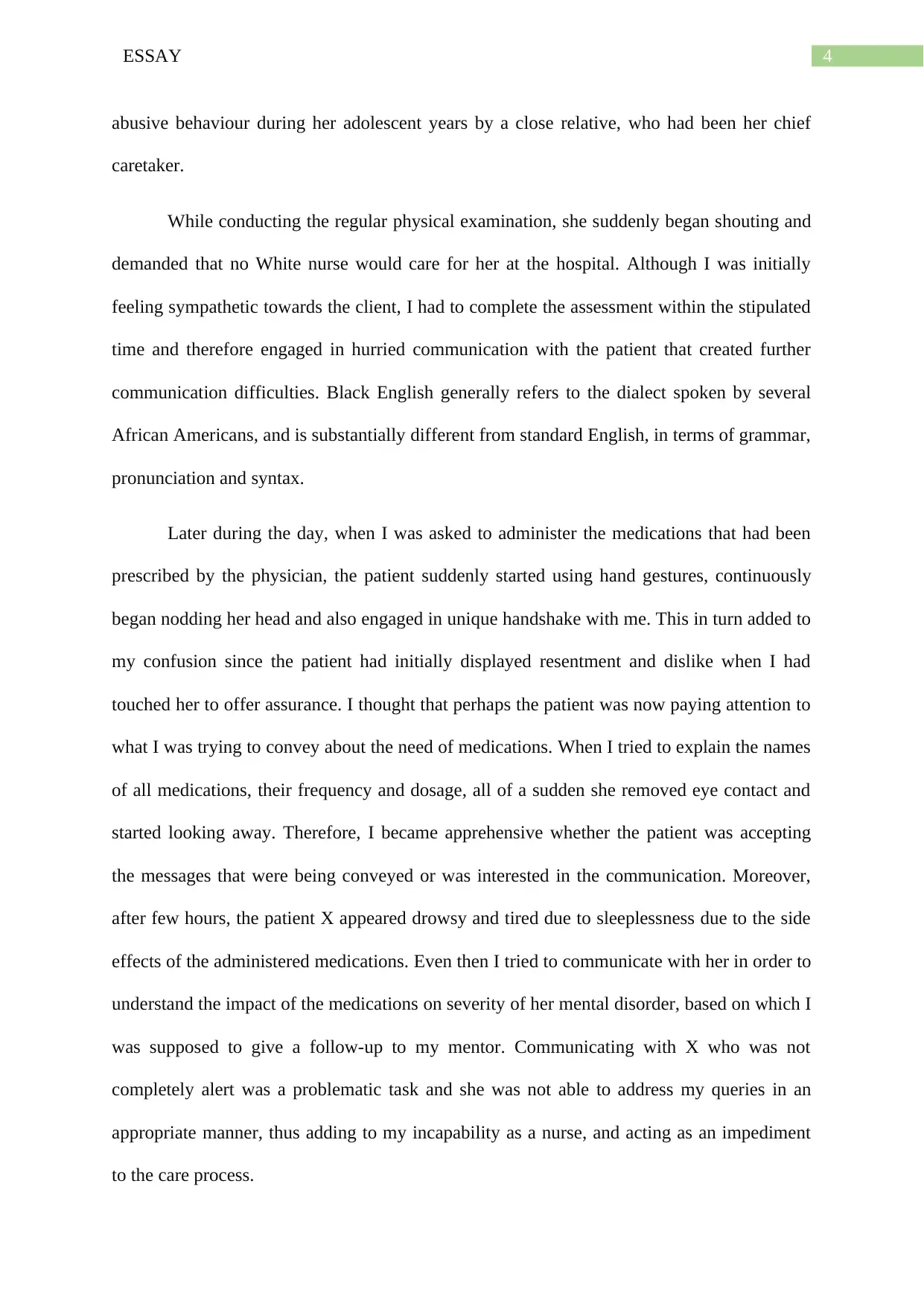
4ESSAY
abusive behaviour during her adolescent years by a close relative, who had been her chief
caretaker.
While conducting the regular physical examination, she suddenly began shouting and
demanded that no White nurse would care for her at the hospital. Although I was initially
feeling sympathetic towards the client, I had to complete the assessment within the stipulated
time and therefore engaged in hurried communication with the patient that created further
communication difficulties. Black English generally refers to the dialect spoken by several
African Americans, and is substantially different from standard English, in terms of grammar,
pronunciation and syntax.
Later during the day, when I was asked to administer the medications that had been
prescribed by the physician, the patient suddenly started using hand gestures, continuously
began nodding her head and also engaged in unique handshake with me. This in turn added to
my confusion since the patient had initially displayed resentment and dislike when I had
touched her to offer assurance. I thought that perhaps the patient was now paying attention to
what I was trying to convey about the need of medications. When I tried to explain the names
of all medications, their frequency and dosage, all of a sudden she removed eye contact and
started looking away. Therefore, I became apprehensive whether the patient was accepting
the messages that were being conveyed or was interested in the communication. Moreover,
after few hours, the patient X appeared drowsy and tired due to sleeplessness due to the side
effects of the administered medications. Even then I tried to communicate with her in order to
understand the impact of the medications on severity of her mental disorder, based on which I
was supposed to give a follow-up to my mentor. Communicating with X who was not
completely alert was a problematic task and she was not able to address my queries in an
appropriate manner, thus adding to my incapability as a nurse, and acting as an impediment
to the care process.
abusive behaviour during her adolescent years by a close relative, who had been her chief
caretaker.
While conducting the regular physical examination, she suddenly began shouting and
demanded that no White nurse would care for her at the hospital. Although I was initially
feeling sympathetic towards the client, I had to complete the assessment within the stipulated
time and therefore engaged in hurried communication with the patient that created further
communication difficulties. Black English generally refers to the dialect spoken by several
African Americans, and is substantially different from standard English, in terms of grammar,
pronunciation and syntax.
Later during the day, when I was asked to administer the medications that had been
prescribed by the physician, the patient suddenly started using hand gestures, continuously
began nodding her head and also engaged in unique handshake with me. This in turn added to
my confusion since the patient had initially displayed resentment and dislike when I had
touched her to offer assurance. I thought that perhaps the patient was now paying attention to
what I was trying to convey about the need of medications. When I tried to explain the names
of all medications, their frequency and dosage, all of a sudden she removed eye contact and
started looking away. Therefore, I became apprehensive whether the patient was accepting
the messages that were being conveyed or was interested in the communication. Moreover,
after few hours, the patient X appeared drowsy and tired due to sleeplessness due to the side
effects of the administered medications. Even then I tried to communicate with her in order to
understand the impact of the medications on severity of her mental disorder, based on which I
was supposed to give a follow-up to my mentor. Communicating with X who was not
completely alert was a problematic task and she was not able to address my queries in an
appropriate manner, thus adding to my incapability as a nurse, and acting as an impediment
to the care process.
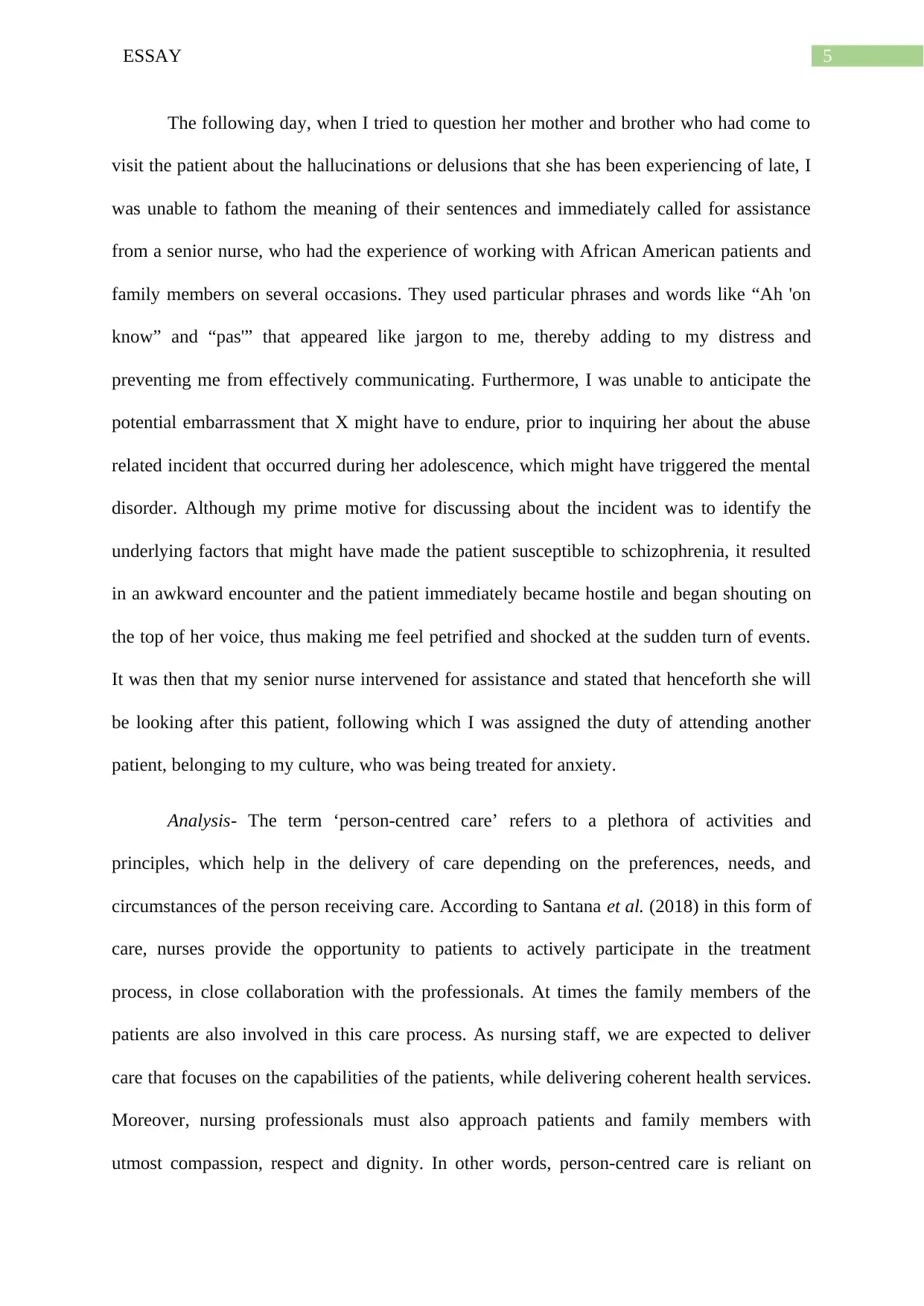
5ESSAY
The following day, when I tried to question her mother and brother who had come to
visit the patient about the hallucinations or delusions that she has been experiencing of late, I
was unable to fathom the meaning of their sentences and immediately called for assistance
from a senior nurse, who had the experience of working with African American patients and
family members on several occasions. They used particular phrases and words like “Ah 'on
know” and “pas'” that appeared like jargon to me, thereby adding to my distress and
preventing me from effectively communicating. Furthermore, I was unable to anticipate the
potential embarrassment that X might have to endure, prior to inquiring her about the abuse
related incident that occurred during her adolescence, which might have triggered the mental
disorder. Although my prime motive for discussing about the incident was to identify the
underlying factors that might have made the patient susceptible to schizophrenia, it resulted
in an awkward encounter and the patient immediately became hostile and began shouting on
the top of her voice, thus making me feel petrified and shocked at the sudden turn of events.
It was then that my senior nurse intervened for assistance and stated that henceforth she will
be looking after this patient, following which I was assigned the duty of attending another
patient, belonging to my culture, who was being treated for anxiety.
Analysis- The term ‘person-centred care’ refers to a plethora of activities and
principles, which help in the delivery of care depending on the preferences, needs, and
circumstances of the person receiving care. According to Santana et al. (2018) in this form of
care, nurses provide the opportunity to patients to actively participate in the treatment
process, in close collaboration with the professionals. At times the family members of the
patients are also involved in this care process. As nursing staff, we are expected to deliver
care that focuses on the capabilities of the patients, while delivering coherent health services.
Moreover, nursing professionals must also approach patients and family members with
utmost compassion, respect and dignity. In other words, person-centred care is reliant on
The following day, when I tried to question her mother and brother who had come to
visit the patient about the hallucinations or delusions that she has been experiencing of late, I
was unable to fathom the meaning of their sentences and immediately called for assistance
from a senior nurse, who had the experience of working with African American patients and
family members on several occasions. They used particular phrases and words like “Ah 'on
know” and “pas'” that appeared like jargon to me, thereby adding to my distress and
preventing me from effectively communicating. Furthermore, I was unable to anticipate the
potential embarrassment that X might have to endure, prior to inquiring her about the abuse
related incident that occurred during her adolescence, which might have triggered the mental
disorder. Although my prime motive for discussing about the incident was to identify the
underlying factors that might have made the patient susceptible to schizophrenia, it resulted
in an awkward encounter and the patient immediately became hostile and began shouting on
the top of her voice, thus making me feel petrified and shocked at the sudden turn of events.
It was then that my senior nurse intervened for assistance and stated that henceforth she will
be looking after this patient, following which I was assigned the duty of attending another
patient, belonging to my culture, who was being treated for anxiety.
Analysis- The term ‘person-centred care’ refers to a plethora of activities and
principles, which help in the delivery of care depending on the preferences, needs, and
circumstances of the person receiving care. According to Santana et al. (2018) in this form of
care, nurses provide the opportunity to patients to actively participate in the treatment
process, in close collaboration with the professionals. At times the family members of the
patients are also involved in this care process. As nursing staff, we are expected to deliver
care that focuses on the capabilities of the patients, while delivering coherent health services.
Moreover, nursing professionals must also approach patients and family members with
utmost compassion, respect and dignity. In other words, person-centred care is reliant on
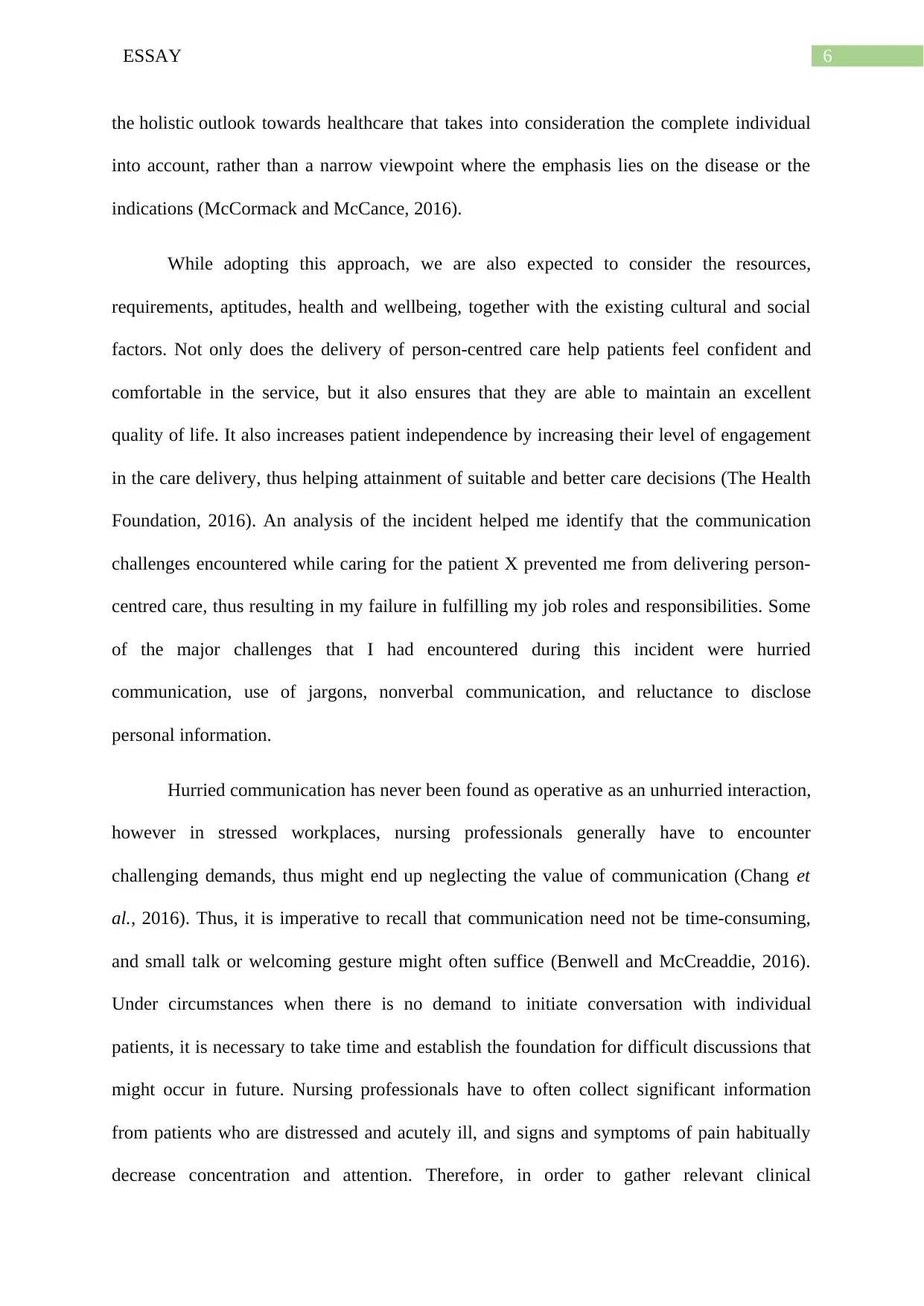
6ESSAY
the holistic outlook towards healthcare that takes into consideration the complete individual
into account, rather than a narrow viewpoint where the emphasis lies on the disease or the
indications (McCormack and McCance, 2016).
While adopting this approach, we are also expected to consider the resources,
requirements, aptitudes, health and wellbeing, together with the existing cultural and social
factors. Not only does the delivery of person-centred care help patients feel confident and
comfortable in the service, but it also ensures that they are able to maintain an excellent
quality of life. It also increases patient independence by increasing their level of engagement
in the care delivery, thus helping attainment of suitable and better care decisions (The Health
Foundation, 2016). An analysis of the incident helped me identify that the communication
challenges encountered while caring for the patient X prevented me from delivering person-
centred care, thus resulting in my failure in fulfilling my job roles and responsibilities. Some
of the major challenges that I had encountered during this incident were hurried
communication, use of jargons, nonverbal communication, and reluctance to disclose
personal information.
Hurried communication has never been found as operative as an unhurried interaction,
however in stressed workplaces, nursing professionals generally have to encounter
challenging demands, thus might end up neglecting the value of communication (Chang et
al., 2016). Thus, it is imperative to recall that communication need not be time-consuming,
and small talk or welcoming gesture might often suffice (Benwell and McCreaddie, 2016).
Under circumstances when there is no demand to initiate conversation with individual
patients, it is necessary to take time and establish the foundation for difficult discussions that
might occur in future. Nursing professionals have to often collect significant information
from patients who are distressed and acutely ill, and signs and symptoms of pain habitually
decrease concentration and attention. Therefore, in order to gather relevant clinical
the holistic outlook towards healthcare that takes into consideration the complete individual
into account, rather than a narrow viewpoint where the emphasis lies on the disease or the
indications (McCormack and McCance, 2016).
While adopting this approach, we are also expected to consider the resources,
requirements, aptitudes, health and wellbeing, together with the existing cultural and social
factors. Not only does the delivery of person-centred care help patients feel confident and
comfortable in the service, but it also ensures that they are able to maintain an excellent
quality of life. It also increases patient independence by increasing their level of engagement
in the care delivery, thus helping attainment of suitable and better care decisions (The Health
Foundation, 2016). An analysis of the incident helped me identify that the communication
challenges encountered while caring for the patient X prevented me from delivering person-
centred care, thus resulting in my failure in fulfilling my job roles and responsibilities. Some
of the major challenges that I had encountered during this incident were hurried
communication, use of jargons, nonverbal communication, and reluctance to disclose
personal information.
Hurried communication has never been found as operative as an unhurried interaction,
however in stressed workplaces, nursing professionals generally have to encounter
challenging demands, thus might end up neglecting the value of communication (Chang et
al., 2016). Thus, it is imperative to recall that communication need not be time-consuming,
and small talk or welcoming gesture might often suffice (Benwell and McCreaddie, 2016).
Under circumstances when there is no demand to initiate conversation with individual
patients, it is necessary to take time and establish the foundation for difficult discussions that
might occur in future. Nursing professionals have to often collect significant information
from patients who are distressed and acutely ill, and signs and symptoms of pain habitually
decrease concentration and attention. Therefore, in order to gather relevant clinical
Paraphrase This Document
Need a fresh take? Get an instant paraphrase of this document with our AI Paraphraser
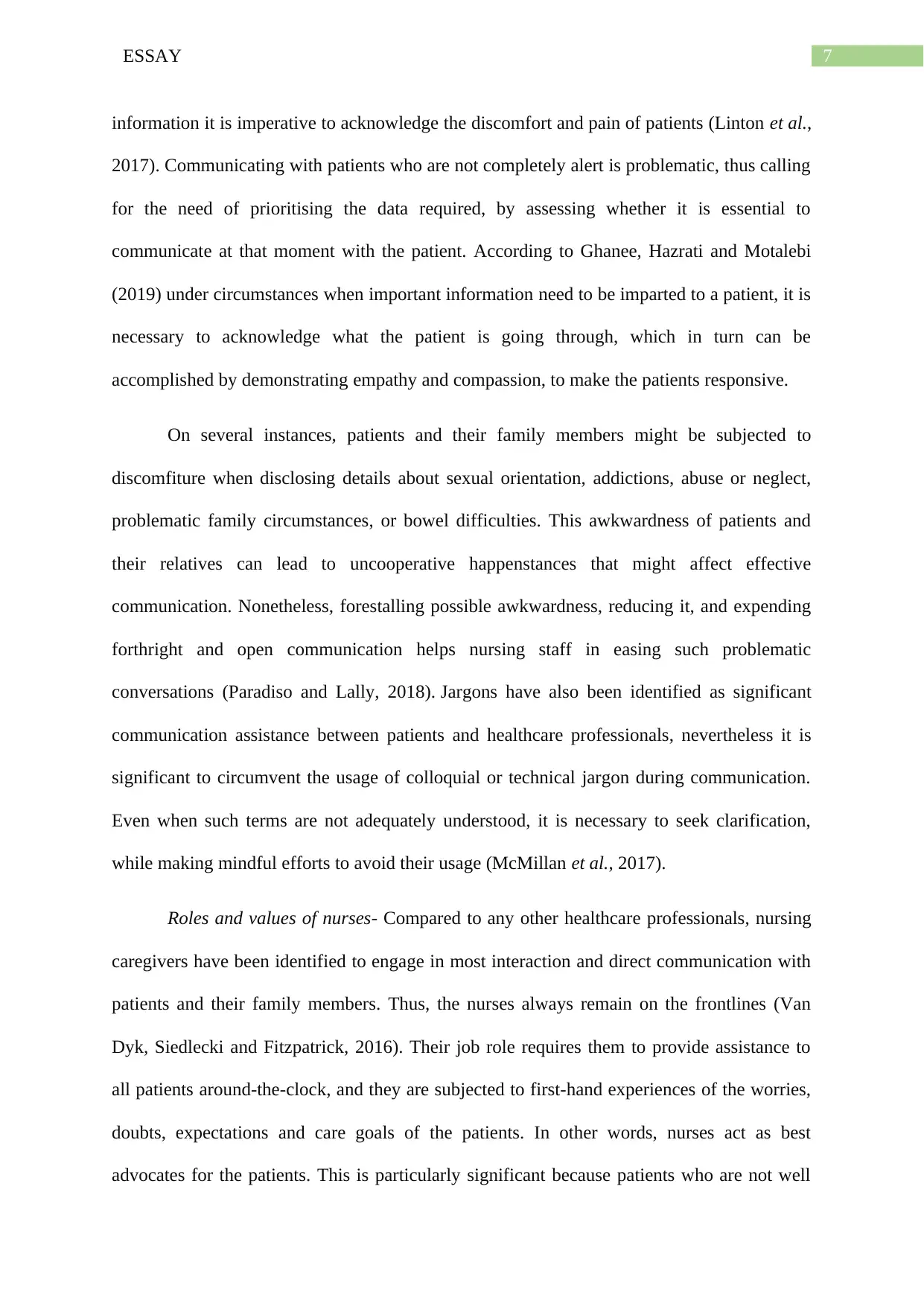
7ESSAY
information it is imperative to acknowledge the discomfort and pain of patients (Linton et al.,
2017). Communicating with patients who are not completely alert is problematic, thus calling
for the need of prioritising the data required, by assessing whether it is essential to
communicate at that moment with the patient. According to Ghanee, Hazrati and Motalebi
(2019) under circumstances when important information need to be imparted to a patient, it is
necessary to acknowledge what the patient is going through, which in turn can be
accomplished by demonstrating empathy and compassion, to make the patients responsive.
On several instances, patients and their family members might be subjected to
discomfiture when disclosing details about sexual orientation, addictions, abuse or neglect,
problematic family circumstances, or bowel difficulties. This awkwardness of patients and
their relatives can lead to uncooperative happenstances that might affect effective
communication. Nonetheless, forestalling possible awkwardness, reducing it, and expending
forthright and open communication helps nursing staff in easing such problematic
conversations (Paradiso and Lally, 2018). Jargons have also been identified as significant
communication assistance between patients and healthcare professionals, nevertheless it is
significant to circumvent the usage of colloquial or technical jargon during communication.
Even when such terms are not adequately understood, it is necessary to seek clarification,
while making mindful efforts to avoid their usage (McMillan et al., 2017).
Roles and values of nurses- Compared to any other healthcare professionals, nursing
caregivers have been identified to engage in most interaction and direct communication with
patients and their family members. Thus, the nurses always remain on the frontlines (Van
Dyk, Siedlecki and Fitzpatrick, 2016). Their job role requires them to provide assistance to
all patients around-the-clock, and they are subjected to first-hand experiences of the worries,
doubts, expectations and care goals of the patients. In other words, nurses act as best
advocates for the patients. This is particularly significant because patients who are not well
information it is imperative to acknowledge the discomfort and pain of patients (Linton et al.,
2017). Communicating with patients who are not completely alert is problematic, thus calling
for the need of prioritising the data required, by assessing whether it is essential to
communicate at that moment with the patient. According to Ghanee, Hazrati and Motalebi
(2019) under circumstances when important information need to be imparted to a patient, it is
necessary to acknowledge what the patient is going through, which in turn can be
accomplished by demonstrating empathy and compassion, to make the patients responsive.
On several instances, patients and their family members might be subjected to
discomfiture when disclosing details about sexual orientation, addictions, abuse or neglect,
problematic family circumstances, or bowel difficulties. This awkwardness of patients and
their relatives can lead to uncooperative happenstances that might affect effective
communication. Nonetheless, forestalling possible awkwardness, reducing it, and expending
forthright and open communication helps nursing staff in easing such problematic
conversations (Paradiso and Lally, 2018). Jargons have also been identified as significant
communication assistance between patients and healthcare professionals, nevertheless it is
significant to circumvent the usage of colloquial or technical jargon during communication.
Even when such terms are not adequately understood, it is necessary to seek clarification,
while making mindful efforts to avoid their usage (McMillan et al., 2017).
Roles and values of nurses- Compared to any other healthcare professionals, nursing
caregivers have been identified to engage in most interaction and direct communication with
patients and their family members. Thus, the nurses always remain on the frontlines (Van
Dyk, Siedlecki and Fitzpatrick, 2016). Their job role requires them to provide assistance to
all patients around-the-clock, and they are subjected to first-hand experiences of the worries,
doubts, expectations and care goals of the patients. In other words, nurses act as best
advocates for the patients. This is particularly significant because patients who are not well
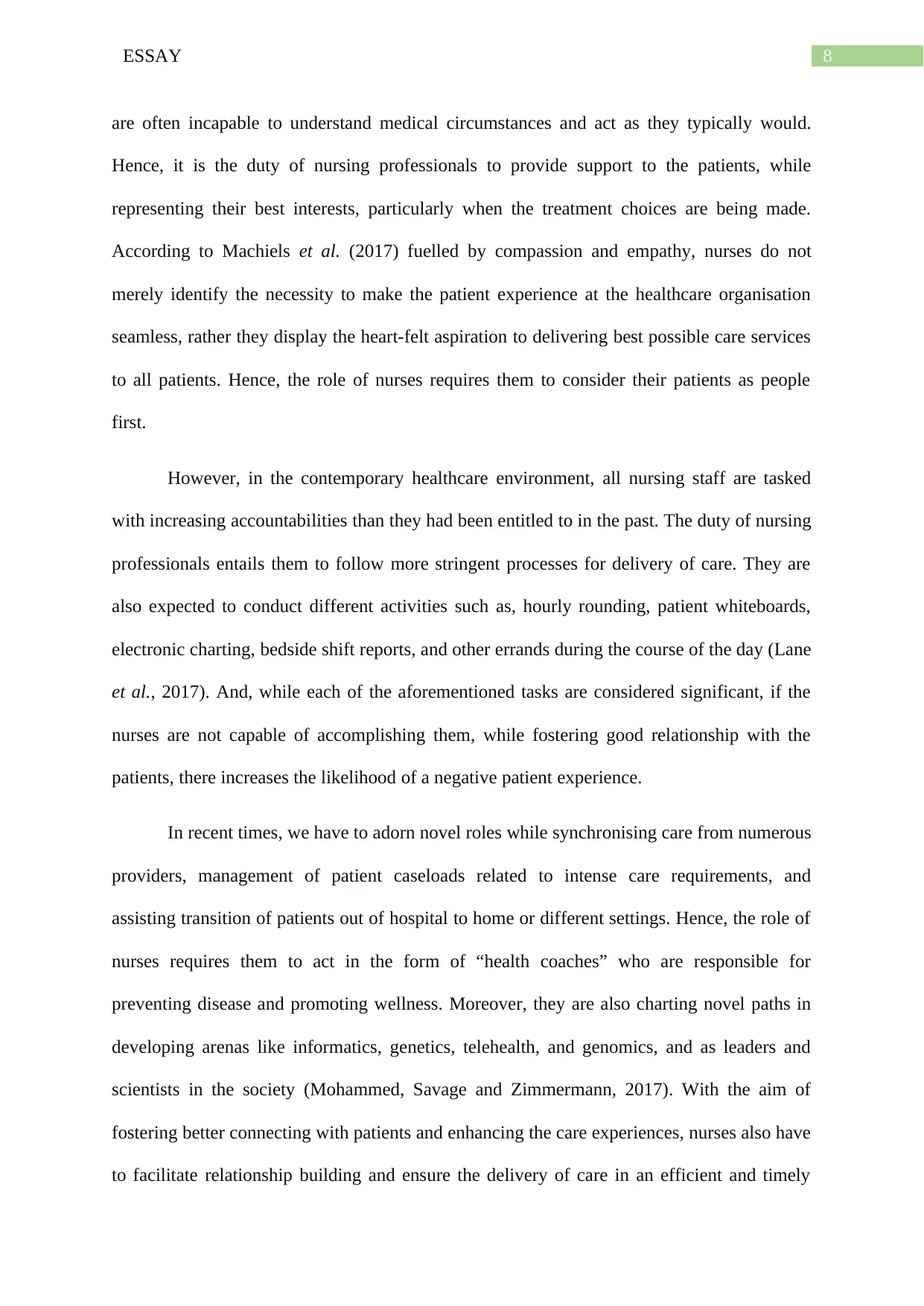
8ESSAY
are often incapable to understand medical circumstances and act as they typically would.
Hence, it is the duty of nursing professionals to provide support to the patients, while
representing their best interests, particularly when the treatment choices are being made.
According to Machiels et al. (2017) fuelled by compassion and empathy, nurses do not
merely identify the necessity to make the patient experience at the healthcare organisation
seamless, rather they display the heart-felt aspiration to delivering best possible care services
to all patients. Hence, the role of nurses requires them to consider their patients as people
first.
However, in the contemporary healthcare environment, all nursing staff are tasked
with increasing accountabilities than they had been entitled to in the past. The duty of nursing
professionals entails them to follow more stringent processes for delivery of care. They are
also expected to conduct different activities such as, hourly rounding, patient whiteboards,
electronic charting, bedside shift reports, and other errands during the course of the day (Lane
et al., 2017). And, while each of the aforementioned tasks are considered significant, if the
nurses are not capable of accomplishing them, while fostering good relationship with the
patients, there increases the likelihood of a negative patient experience.
In recent times, we have to adorn novel roles while synchronising care from numerous
providers, management of patient caseloads related to intense care requirements, and
assisting transition of patients out of hospital to home or different settings. Hence, the role of
nurses requires them to act in the form of “health coaches” who are responsible for
preventing disease and promoting wellness. Moreover, they are also charting novel paths in
developing arenas like informatics, genetics, telehealth, and genomics, and as leaders and
scientists in the society (Mohammed, Savage and Zimmermann, 2017). With the aim of
fostering better connecting with patients and enhancing the care experiences, nurses also have
to facilitate relationship building and ensure the delivery of care in an efficient and timely
are often incapable to understand medical circumstances and act as they typically would.
Hence, it is the duty of nursing professionals to provide support to the patients, while
representing their best interests, particularly when the treatment choices are being made.
According to Machiels et al. (2017) fuelled by compassion and empathy, nurses do not
merely identify the necessity to make the patient experience at the healthcare organisation
seamless, rather they display the heart-felt aspiration to delivering best possible care services
to all patients. Hence, the role of nurses requires them to consider their patients as people
first.
However, in the contemporary healthcare environment, all nursing staff are tasked
with increasing accountabilities than they had been entitled to in the past. The duty of nursing
professionals entails them to follow more stringent processes for delivery of care. They are
also expected to conduct different activities such as, hourly rounding, patient whiteboards,
electronic charting, bedside shift reports, and other errands during the course of the day (Lane
et al., 2017). And, while each of the aforementioned tasks are considered significant, if the
nurses are not capable of accomplishing them, while fostering good relationship with the
patients, there increases the likelihood of a negative patient experience.
In recent times, we have to adorn novel roles while synchronising care from numerous
providers, management of patient caseloads related to intense care requirements, and
assisting transition of patients out of hospital to home or different settings. Hence, the role of
nurses requires them to act in the form of “health coaches” who are responsible for
preventing disease and promoting wellness. Moreover, they are also charting novel paths in
developing arenas like informatics, genetics, telehealth, and genomics, and as leaders and
scientists in the society (Mohammed, Savage and Zimmermann, 2017). With the aim of
fostering better connecting with patients and enhancing the care experiences, nurses also have
to facilitate relationship building and ensure the delivery of care in an efficient and timely
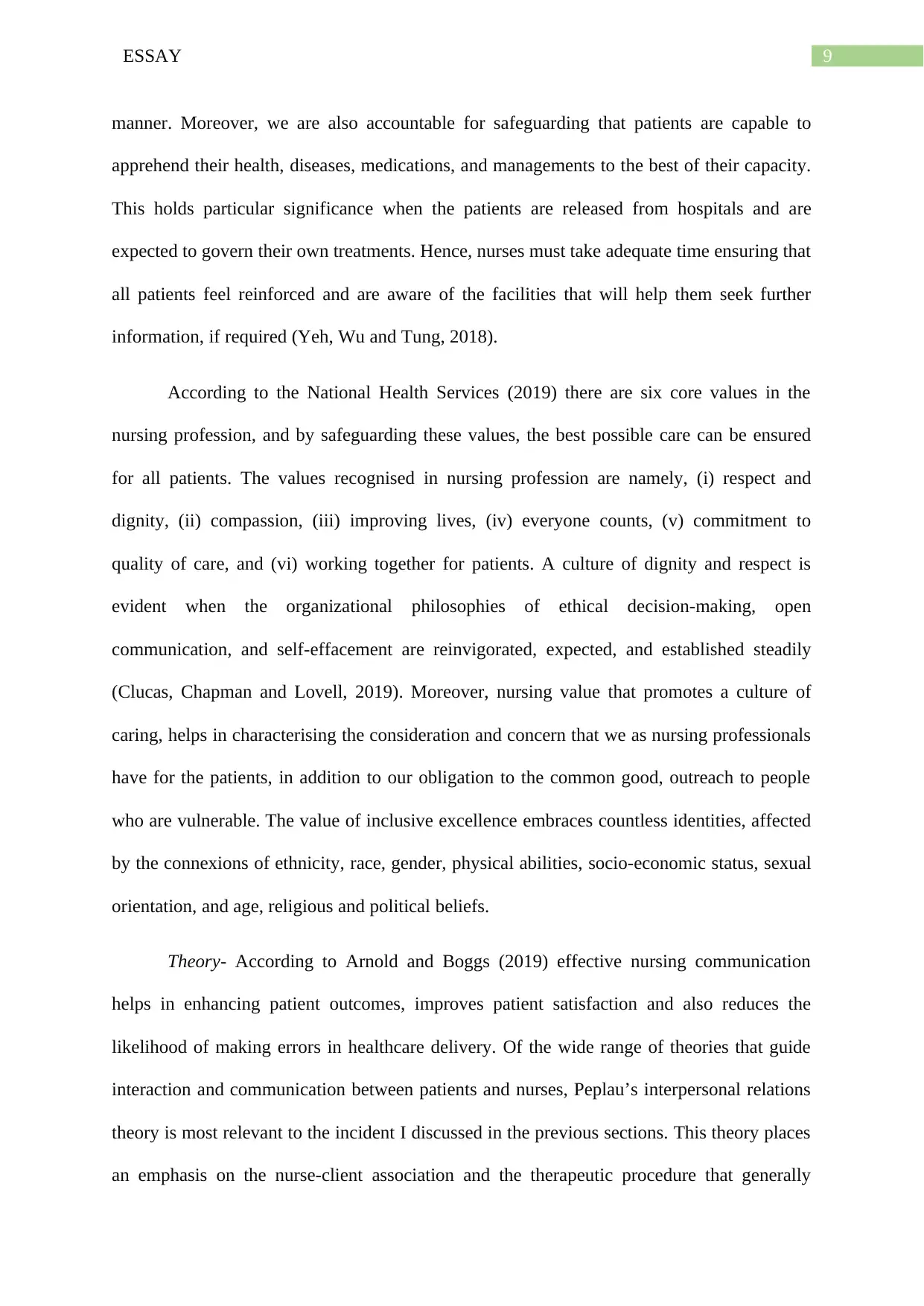
9ESSAY
manner. Moreover, we are also accountable for safeguarding that patients are capable to
apprehend their health, diseases, medications, and managements to the best of their capacity.
This holds particular significance when the patients are released from hospitals and are
expected to govern their own treatments. Hence, nurses must take adequate time ensuring that
all patients feel reinforced and are aware of the facilities that will help them seek further
information, if required (Yeh, Wu and Tung, 2018).
According to the National Health Services (2019) there are six core values in the
nursing profession, and by safeguarding these values, the best possible care can be ensured
for all patients. The values recognised in nursing profession are namely, (i) respect and
dignity, (ii) compassion, (iii) improving lives, (iv) everyone counts, (v) commitment to
quality of care, and (vi) working together for patients. A culture of dignity and respect is
evident when the organizational philosophies of ethical decision-making, open
communication, and self-effacement are reinvigorated, expected, and established steadily
(Clucas, Chapman and Lovell, 2019). Moreover, nursing value that promotes a culture of
caring, helps in characterising the consideration and concern that we as nursing professionals
have for the patients, in addition to our obligation to the common good, outreach to people
who are vulnerable. The value of inclusive excellence embraces countless identities, affected
by the connexions of ethnicity, race, gender, physical abilities, socio-economic status, sexual
orientation, and age, religious and political beliefs.
Theory- According to Arnold and Boggs (2019) effective nursing communication
helps in enhancing patient outcomes, improves patient satisfaction and also reduces the
likelihood of making errors in healthcare delivery. Of the wide range of theories that guide
interaction and communication between patients and nurses, Peplau’s interpersonal relations
theory is most relevant to the incident I discussed in the previous sections. This theory places
an emphasis on the nurse-client association and the therapeutic procedure that generally
manner. Moreover, we are also accountable for safeguarding that patients are capable to
apprehend their health, diseases, medications, and managements to the best of their capacity.
This holds particular significance when the patients are released from hospitals and are
expected to govern their own treatments. Hence, nurses must take adequate time ensuring that
all patients feel reinforced and are aware of the facilities that will help them seek further
information, if required (Yeh, Wu and Tung, 2018).
According to the National Health Services (2019) there are six core values in the
nursing profession, and by safeguarding these values, the best possible care can be ensured
for all patients. The values recognised in nursing profession are namely, (i) respect and
dignity, (ii) compassion, (iii) improving lives, (iv) everyone counts, (v) commitment to
quality of care, and (vi) working together for patients. A culture of dignity and respect is
evident when the organizational philosophies of ethical decision-making, open
communication, and self-effacement are reinvigorated, expected, and established steadily
(Clucas, Chapman and Lovell, 2019). Moreover, nursing value that promotes a culture of
caring, helps in characterising the consideration and concern that we as nursing professionals
have for the patients, in addition to our obligation to the common good, outreach to people
who are vulnerable. The value of inclusive excellence embraces countless identities, affected
by the connexions of ethnicity, race, gender, physical abilities, socio-economic status, sexual
orientation, and age, religious and political beliefs.
Theory- According to Arnold and Boggs (2019) effective nursing communication
helps in enhancing patient outcomes, improves patient satisfaction and also reduces the
likelihood of making errors in healthcare delivery. Of the wide range of theories that guide
interaction and communication between patients and nurses, Peplau’s interpersonal relations
theory is most relevant to the incident I discussed in the previous sections. This theory places
an emphasis on the nurse-client association and the therapeutic procedure that generally
Secure Best Marks with AI Grader
Need help grading? Try our AI Grader for instant feedback on your assignments.
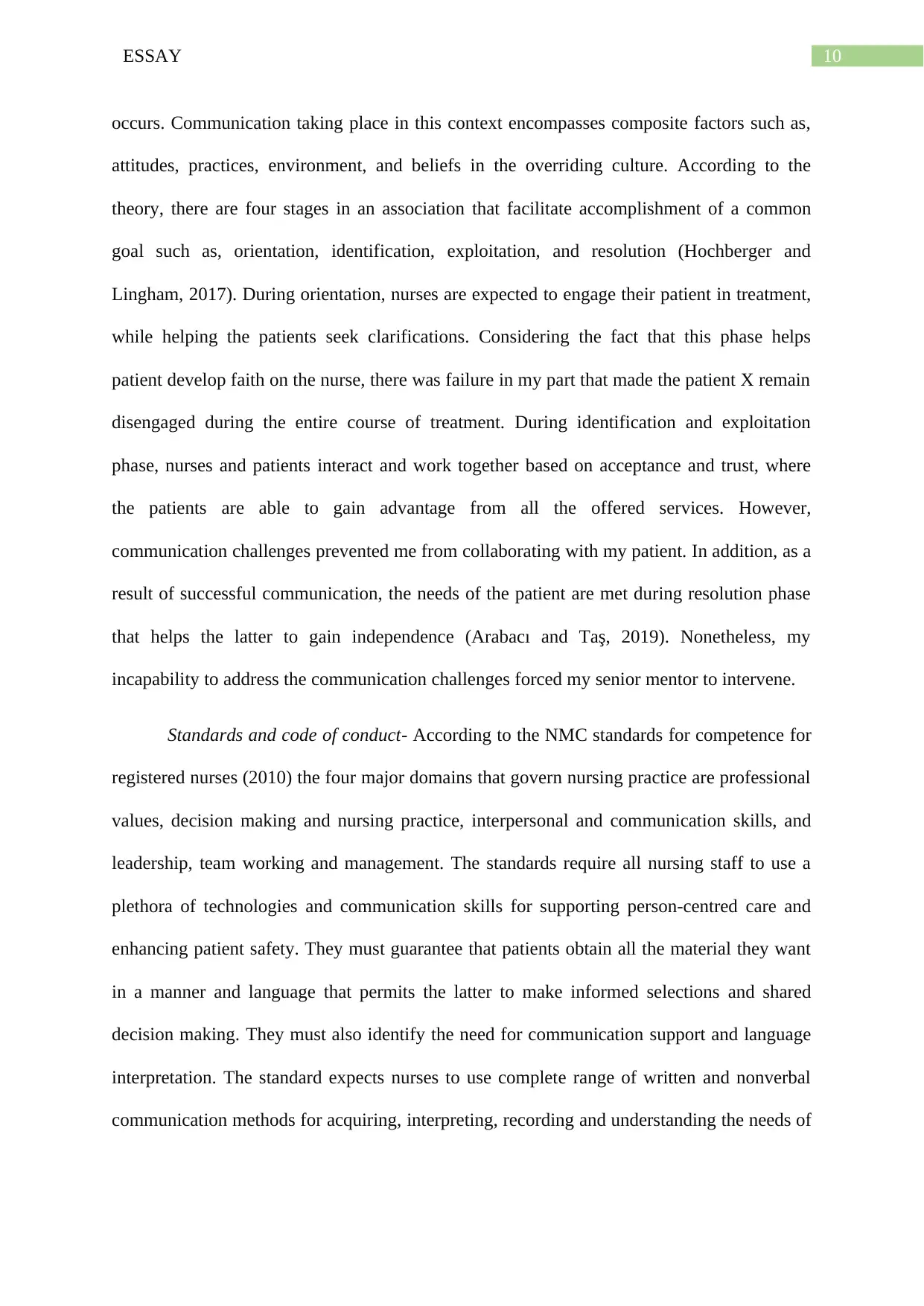
10ESSAY
occurs. Communication taking place in this context encompasses composite factors such as,
attitudes, practices, environment, and beliefs in the overriding culture. According to the
theory, there are four stages in an association that facilitate accomplishment of a common
goal such as, orientation, identification, exploitation, and resolution (Hochberger and
Lingham, 2017). During orientation, nurses are expected to engage their patient in treatment,
while helping the patients seek clarifications. Considering the fact that this phase helps
patient develop faith on the nurse, there was failure in my part that made the patient X remain
disengaged during the entire course of treatment. During identification and exploitation
phase, nurses and patients interact and work together based on acceptance and trust, where
the patients are able to gain advantage from all the offered services. However,
communication challenges prevented me from collaborating with my patient. In addition, as a
result of successful communication, the needs of the patient are met during resolution phase
that helps the latter to gain independence (Arabacı and Taş, 2019). Nonetheless, my
incapability to address the communication challenges forced my senior mentor to intervene.
Standards and code of conduct- According to the NMC standards for competence for
registered nurses (2010) the four major domains that govern nursing practice are professional
values, decision making and nursing practice, interpersonal and communication skills, and
leadership, team working and management. The standards require all nursing staff to use a
plethora of technologies and communication skills for supporting person-centred care and
enhancing patient safety. They must guarantee that patients obtain all the material they want
in a manner and language that permits the latter to make informed selections and shared
decision making. They must also identify the need for communication support and language
interpretation. The standard expects nurses to use complete range of written and nonverbal
communication methods for acquiring, interpreting, recording and understanding the needs of
occurs. Communication taking place in this context encompasses composite factors such as,
attitudes, practices, environment, and beliefs in the overriding culture. According to the
theory, there are four stages in an association that facilitate accomplishment of a common
goal such as, orientation, identification, exploitation, and resolution (Hochberger and
Lingham, 2017). During orientation, nurses are expected to engage their patient in treatment,
while helping the patients seek clarifications. Considering the fact that this phase helps
patient develop faith on the nurse, there was failure in my part that made the patient X remain
disengaged during the entire course of treatment. During identification and exploitation
phase, nurses and patients interact and work together based on acceptance and trust, where
the patients are able to gain advantage from all the offered services. However,
communication challenges prevented me from collaborating with my patient. In addition, as a
result of successful communication, the needs of the patient are met during resolution phase
that helps the latter to gain independence (Arabacı and Taş, 2019). Nonetheless, my
incapability to address the communication challenges forced my senior mentor to intervene.
Standards and code of conduct- According to the NMC standards for competence for
registered nurses (2010) the four major domains that govern nursing practice are professional
values, decision making and nursing practice, interpersonal and communication skills, and
leadership, team working and management. The standards require all nursing staff to use a
plethora of technologies and communication skills for supporting person-centred care and
enhancing patient safety. They must guarantee that patients obtain all the material they want
in a manner and language that permits the latter to make informed selections and shared
decision making. They must also identify the need for communication support and language
interpretation. The standard expects nurses to use complete range of written and nonverbal
communication methods for acquiring, interpreting, recording and understanding the needs of
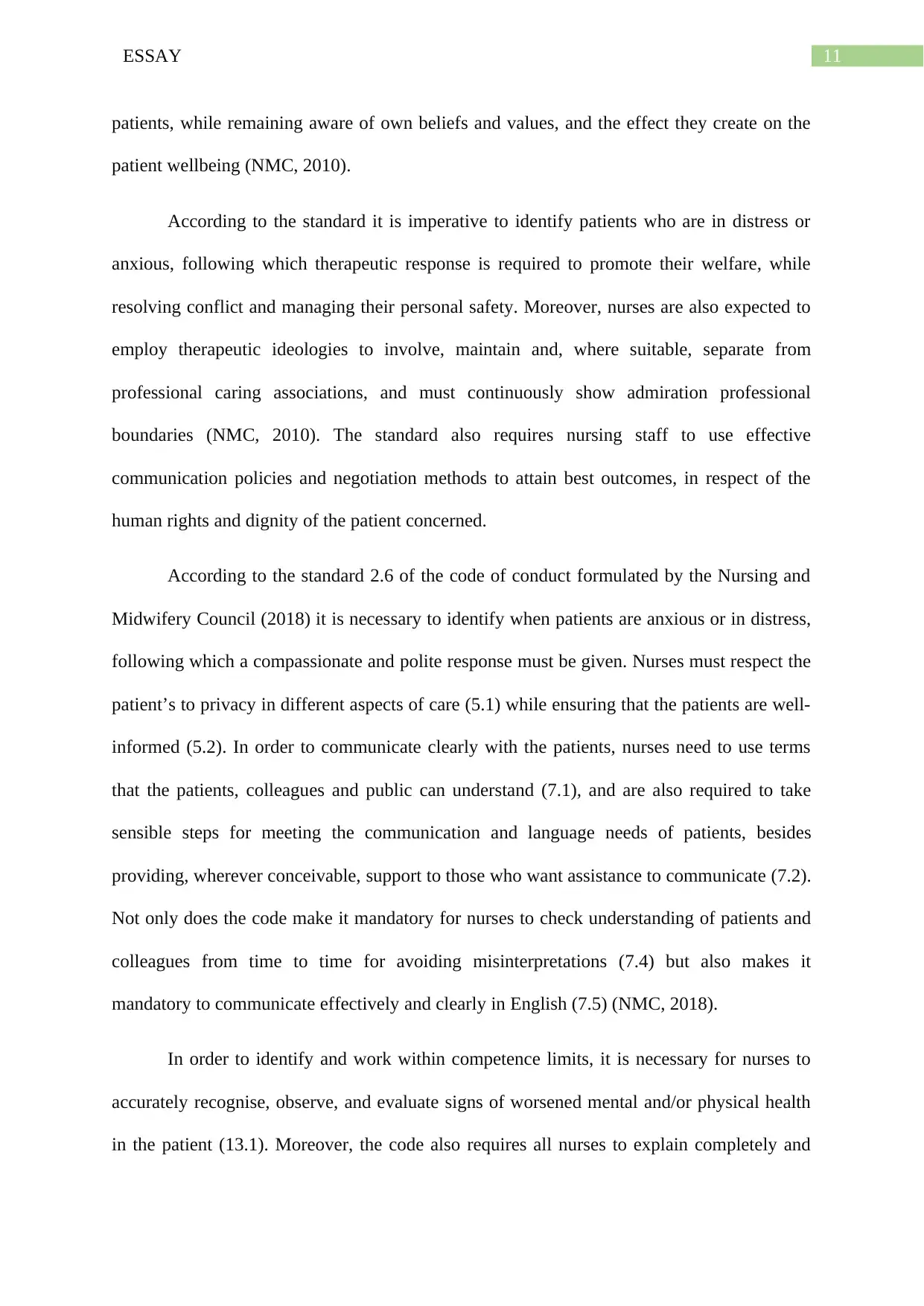
11ESSAY
patients, while remaining aware of own beliefs and values, and the effect they create on the
patient wellbeing (NMC, 2010).
According to the standard it is imperative to identify patients who are in distress or
anxious, following which therapeutic response is required to promote their welfare, while
resolving conflict and managing their personal safety. Moreover, nurses are also expected to
employ therapeutic ideologies to involve, maintain and, where suitable, separate from
professional caring associations, and must continuously show admiration professional
boundaries (NMC, 2010). The standard also requires nursing staff to use effective
communication policies and negotiation methods to attain best outcomes, in respect of the
human rights and dignity of the patient concerned.
According to the standard 2.6 of the code of conduct formulated by the Nursing and
Midwifery Council (2018) it is necessary to identify when patients are anxious or in distress,
following which a compassionate and polite response must be given. Nurses must respect the
patient’s to privacy in different aspects of care (5.1) while ensuring that the patients are well-
informed (5.2). In order to communicate clearly with the patients, nurses need to use terms
that the patients, colleagues and public can understand (7.1), and are also required to take
sensible steps for meeting the communication and language needs of patients, besides
providing, wherever conceivable, support to those who want assistance to communicate (7.2).
Not only does the code make it mandatory for nurses to check understanding of patients and
colleagues from time to time for avoiding misinterpretations (7.4) but also makes it
mandatory to communicate effectively and clearly in English (7.5) (NMC, 2018).
In order to identify and work within competence limits, it is necessary for nurses to
accurately recognise, observe, and evaluate signs of worsened mental and/or physical health
in the patient (13.1). Moreover, the code also requires all nurses to explain completely and
patients, while remaining aware of own beliefs and values, and the effect they create on the
patient wellbeing (NMC, 2010).
According to the standard it is imperative to identify patients who are in distress or
anxious, following which therapeutic response is required to promote their welfare, while
resolving conflict and managing their personal safety. Moreover, nurses are also expected to
employ therapeutic ideologies to involve, maintain and, where suitable, separate from
professional caring associations, and must continuously show admiration professional
boundaries (NMC, 2010). The standard also requires nursing staff to use effective
communication policies and negotiation methods to attain best outcomes, in respect of the
human rights and dignity of the patient concerned.
According to the standard 2.6 of the code of conduct formulated by the Nursing and
Midwifery Council (2018) it is necessary to identify when patients are anxious or in distress,
following which a compassionate and polite response must be given. Nurses must respect the
patient’s to privacy in different aspects of care (5.1) while ensuring that the patients are well-
informed (5.2). In order to communicate clearly with the patients, nurses need to use terms
that the patients, colleagues and public can understand (7.1), and are also required to take
sensible steps for meeting the communication and language needs of patients, besides
providing, wherever conceivable, support to those who want assistance to communicate (7.2).
Not only does the code make it mandatory for nurses to check understanding of patients and
colleagues from time to time for avoiding misinterpretations (7.4) but also makes it
mandatory to communicate effectively and clearly in English (7.5) (NMC, 2018).
In order to identify and work within competence limits, it is necessary for nurses to
accurately recognise, observe, and evaluate signs of worsened mental and/or physical health
in the patient (13.1). Moreover, the code also requires all nurses to explain completely and
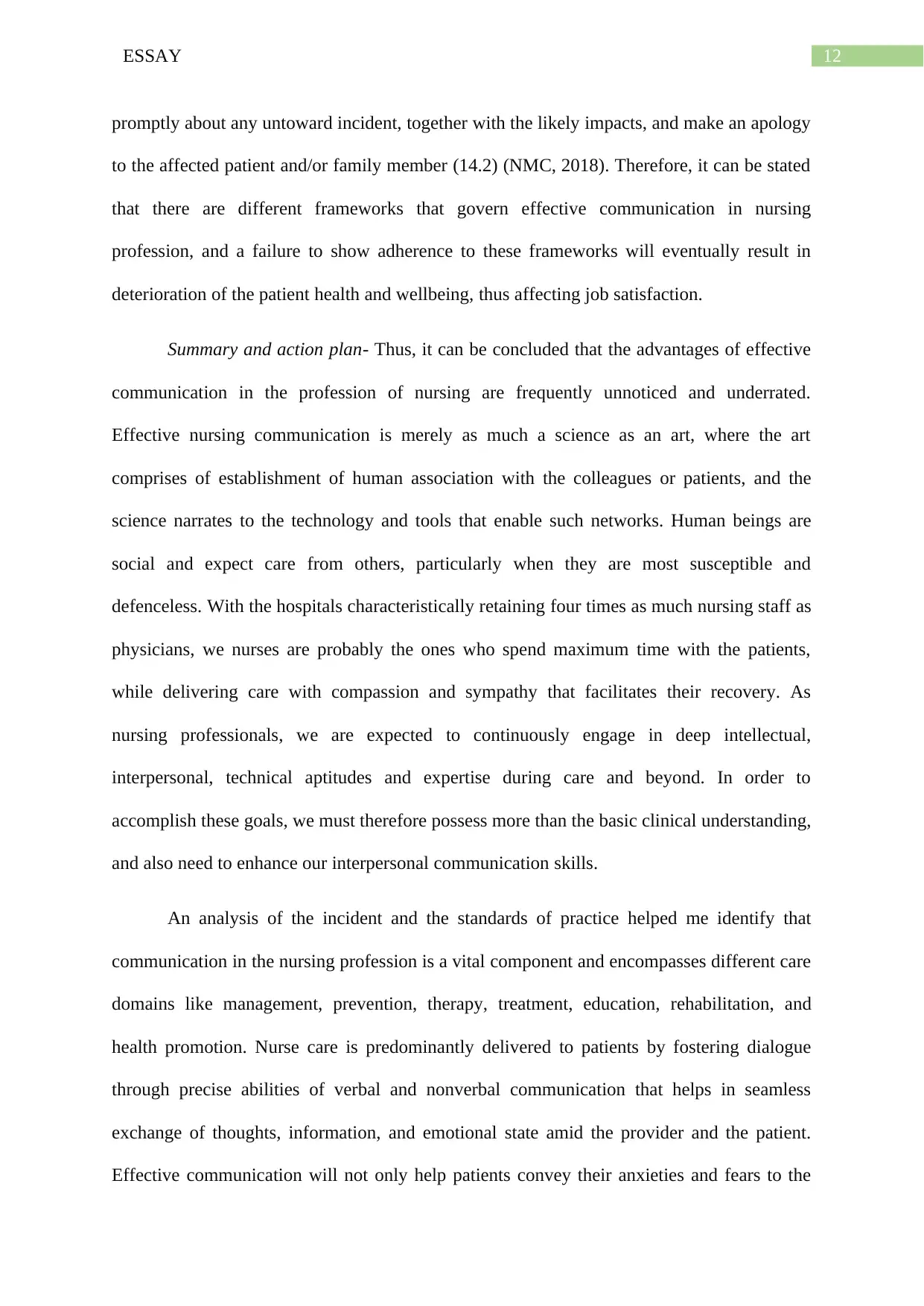
12ESSAY
promptly about any untoward incident, together with the likely impacts, and make an apology
to the affected patient and/or family member (14.2) (NMC, 2018). Therefore, it can be stated
that there are different frameworks that govern effective communication in nursing
profession, and a failure to show adherence to these frameworks will eventually result in
deterioration of the patient health and wellbeing, thus affecting job satisfaction.
Summary and action plan- Thus, it can be concluded that the advantages of effective
communication in the profession of nursing are frequently unnoticed and underrated.
Effective nursing communication is merely as much a science as an art, where the art
comprises of establishment of human association with the colleagues or patients, and the
science narrates to the technology and tools that enable such networks. Human beings are
social and expect care from others, particularly when they are most susceptible and
defenceless. With the hospitals characteristically retaining four times as much nursing staff as
physicians, we nurses are probably the ones who spend maximum time with the patients,
while delivering care with compassion and sympathy that facilitates their recovery. As
nursing professionals, we are expected to continuously engage in deep intellectual,
interpersonal, technical aptitudes and expertise during care and beyond. In order to
accomplish these goals, we must therefore possess more than the basic clinical understanding,
and also need to enhance our interpersonal communication skills.
An analysis of the incident and the standards of practice helped me identify that
communication in the nursing profession is a vital component and encompasses different care
domains like management, prevention, therapy, treatment, education, rehabilitation, and
health promotion. Nurse care is predominantly delivered to patients by fostering dialogue
through precise abilities of verbal and nonverbal communication that helps in seamless
exchange of thoughts, information, and emotional state amid the provider and the patient.
Effective communication will not only help patients convey their anxieties and fears to the
promptly about any untoward incident, together with the likely impacts, and make an apology
to the affected patient and/or family member (14.2) (NMC, 2018). Therefore, it can be stated
that there are different frameworks that govern effective communication in nursing
profession, and a failure to show adherence to these frameworks will eventually result in
deterioration of the patient health and wellbeing, thus affecting job satisfaction.
Summary and action plan- Thus, it can be concluded that the advantages of effective
communication in the profession of nursing are frequently unnoticed and underrated.
Effective nursing communication is merely as much a science as an art, where the art
comprises of establishment of human association with the colleagues or patients, and the
science narrates to the technology and tools that enable such networks. Human beings are
social and expect care from others, particularly when they are most susceptible and
defenceless. With the hospitals characteristically retaining four times as much nursing staff as
physicians, we nurses are probably the ones who spend maximum time with the patients,
while delivering care with compassion and sympathy that facilitates their recovery. As
nursing professionals, we are expected to continuously engage in deep intellectual,
interpersonal, technical aptitudes and expertise during care and beyond. In order to
accomplish these goals, we must therefore possess more than the basic clinical understanding,
and also need to enhance our interpersonal communication skills.
An analysis of the incident and the standards of practice helped me identify that
communication in the nursing profession is a vital component and encompasses different care
domains like management, prevention, therapy, treatment, education, rehabilitation, and
health promotion. Nurse care is predominantly delivered to patients by fostering dialogue
through precise abilities of verbal and nonverbal communication that helps in seamless
exchange of thoughts, information, and emotional state amid the provider and the patient.
Effective communication will not only help patients convey their anxieties and fears to the
Paraphrase This Document
Need a fresh take? Get an instant paraphrase of this document with our AI Paraphraser
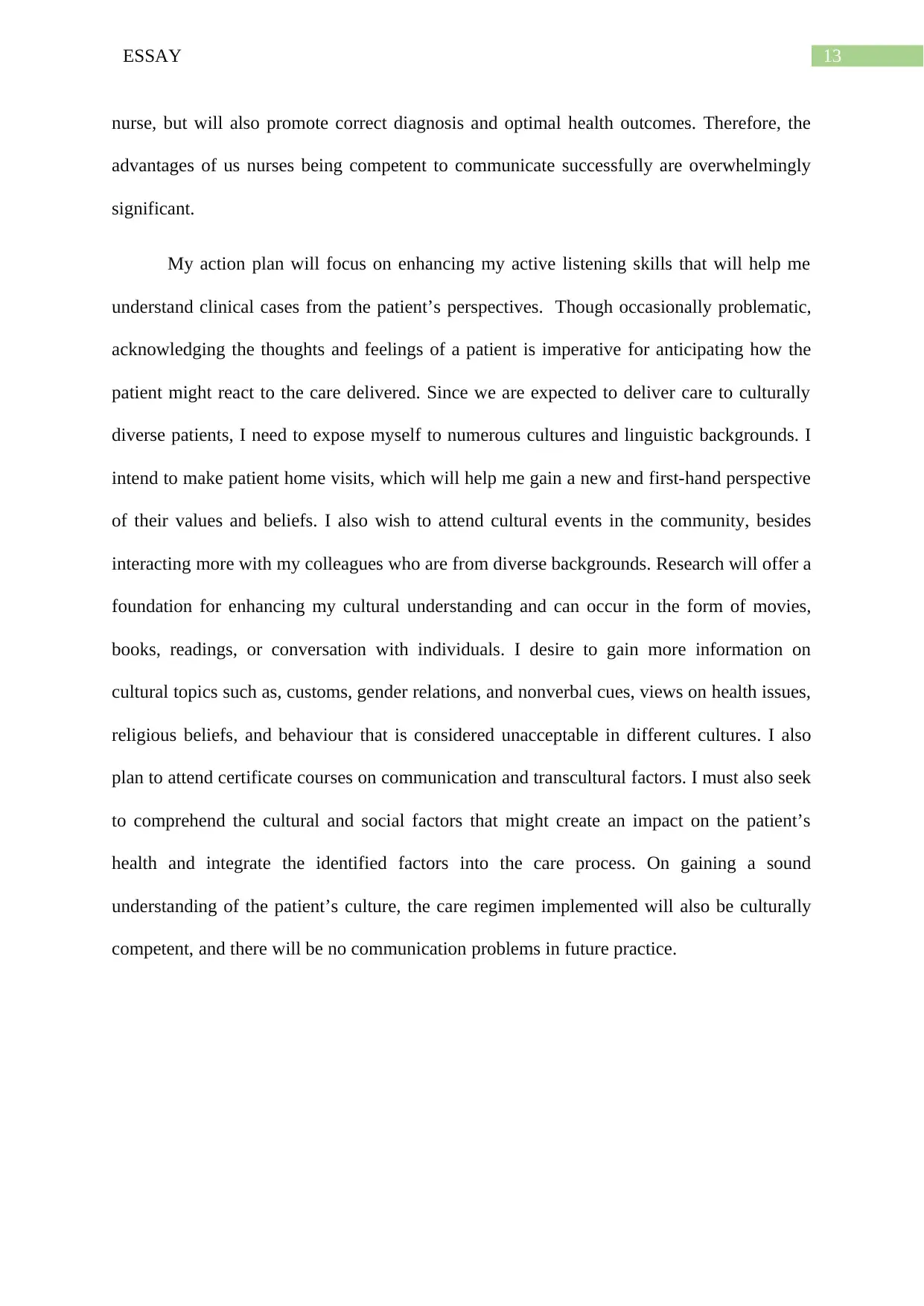
13ESSAY
nurse, but will also promote correct diagnosis and optimal health outcomes. Therefore, the
advantages of us nurses being competent to communicate successfully are overwhelmingly
significant.
My action plan will focus on enhancing my active listening skills that will help me
understand clinical cases from the patient’s perspectives. Though occasionally problematic,
acknowledging the thoughts and feelings of a patient is imperative for anticipating how the
patient might react to the care delivered. Since we are expected to deliver care to culturally
diverse patients, I need to expose myself to numerous cultures and linguistic backgrounds. I
intend to make patient home visits, which will help me gain a new and first-hand perspective
of their values and beliefs. I also wish to attend cultural events in the community, besides
interacting more with my colleagues who are from diverse backgrounds. Research will offer a
foundation for enhancing my cultural understanding and can occur in the form of movies,
books, readings, or conversation with individuals. I desire to gain more information on
cultural topics such as, customs, gender relations, and nonverbal cues, views on health issues,
religious beliefs, and behaviour that is considered unacceptable in different cultures. I also
plan to attend certificate courses on communication and transcultural factors. I must also seek
to comprehend the cultural and social factors that might create an impact on the patient’s
health and integrate the identified factors into the care process. On gaining a sound
understanding of the patient’s culture, the care regimen implemented will also be culturally
competent, and there will be no communication problems in future practice.
nurse, but will also promote correct diagnosis and optimal health outcomes. Therefore, the
advantages of us nurses being competent to communicate successfully are overwhelmingly
significant.
My action plan will focus on enhancing my active listening skills that will help me
understand clinical cases from the patient’s perspectives. Though occasionally problematic,
acknowledging the thoughts and feelings of a patient is imperative for anticipating how the
patient might react to the care delivered. Since we are expected to deliver care to culturally
diverse patients, I need to expose myself to numerous cultures and linguistic backgrounds. I
intend to make patient home visits, which will help me gain a new and first-hand perspective
of their values and beliefs. I also wish to attend cultural events in the community, besides
interacting more with my colleagues who are from diverse backgrounds. Research will offer a
foundation for enhancing my cultural understanding and can occur in the form of movies,
books, readings, or conversation with individuals. I desire to gain more information on
cultural topics such as, customs, gender relations, and nonverbal cues, views on health issues,
religious beliefs, and behaviour that is considered unacceptable in different cultures. I also
plan to attend certificate courses on communication and transcultural factors. I must also seek
to comprehend the cultural and social factors that might create an impact on the patient’s
health and integrate the identified factors into the care process. On gaining a sound
understanding of the patient’s culture, the care regimen implemented will also be culturally
competent, and there will be no communication problems in future practice.
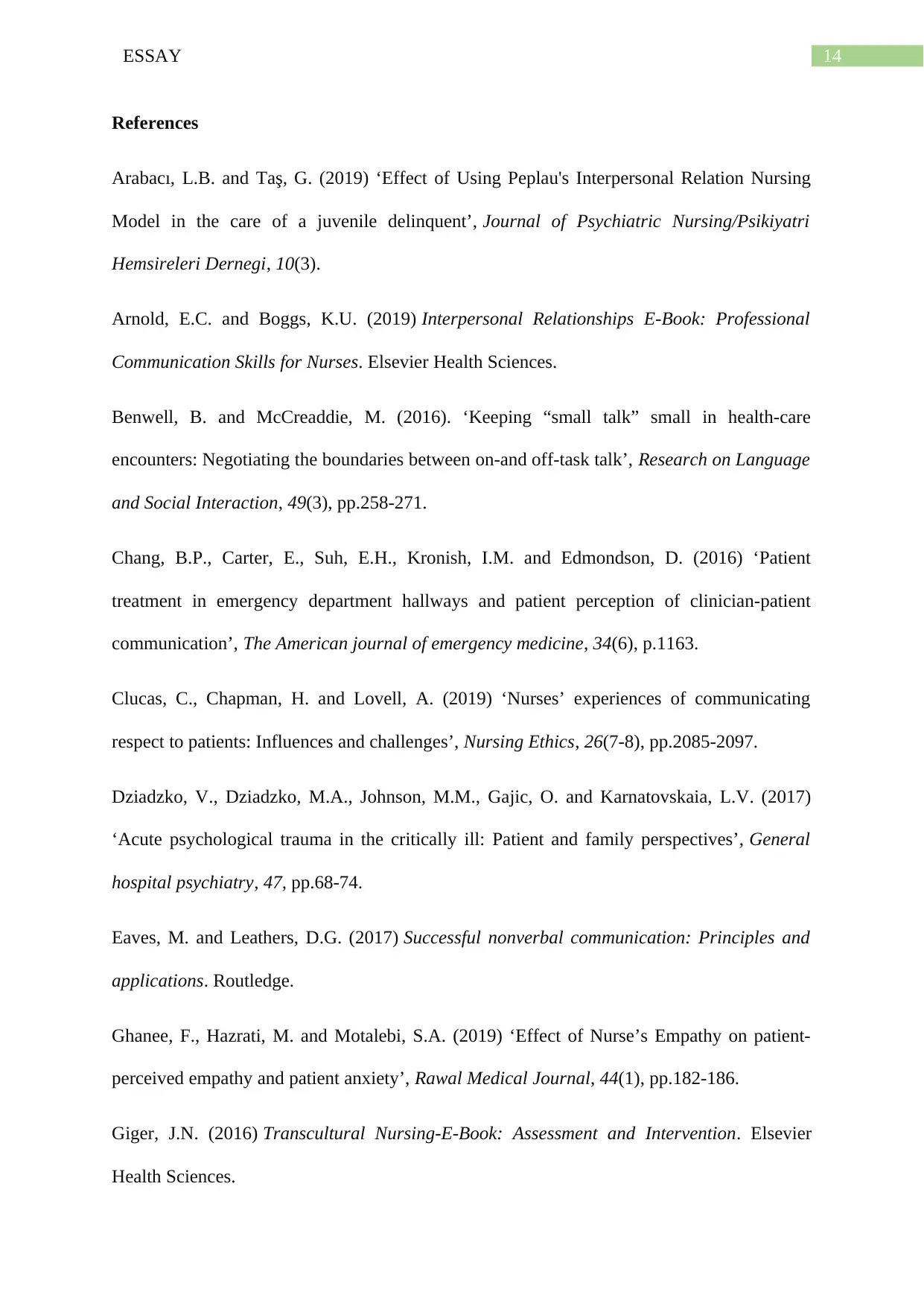
14ESSAY
References
Arabacı, L.B. and Taş, G. (2019) ‘Effect of Using Peplau's Interpersonal Relation Nursing
Model in the care of a juvenile delinquent’, Journal of Psychiatric Nursing/Psikiyatri
Hemsireleri Dernegi, 10(3).
Arnold, E.C. and Boggs, K.U. (2019) Interpersonal Relationships E-Book: Professional
Communication Skills for Nurses. Elsevier Health Sciences.
Benwell, B. and McCreaddie, M. (2016). ‘Keeping “small talk” small in health-care
encounters: Negotiating the boundaries between on-and off-task talk’, Research on Language
and Social Interaction, 49(3), pp.258-271.
Chang, B.P., Carter, E., Suh, E.H., Kronish, I.M. and Edmondson, D. (2016) ‘Patient
treatment in emergency department hallways and patient perception of clinician-patient
communication’, The American journal of emergency medicine, 34(6), p.1163.
Clucas, C., Chapman, H. and Lovell, A. (2019) ‘Nurses’ experiences of communicating
respect to patients: Influences and challenges’, Nursing Ethics, 26(7-8), pp.2085-2097.
Dziadzko, V., Dziadzko, M.A., Johnson, M.M., Gajic, O. and Karnatovskaia, L.V. (2017)
‘Acute psychological trauma in the critically ill: Patient and family perspectives’, General
hospital psychiatry, 47, pp.68-74.
Eaves, M. and Leathers, D.G. (2017) Successful nonverbal communication: Principles and
applications. Routledge.
Ghanee, F., Hazrati, M. and Motalebi, S.A. (2019) ‘Effect of Nurse’s Empathy on patient-
perceived empathy and patient anxiety’, Rawal Medical Journal, 44(1), pp.182-186.
Giger, J.N. (2016) Transcultural Nursing-E-Book: Assessment and Intervention. Elsevier
Health Sciences.
References
Arabacı, L.B. and Taş, G. (2019) ‘Effect of Using Peplau's Interpersonal Relation Nursing
Model in the care of a juvenile delinquent’, Journal of Psychiatric Nursing/Psikiyatri
Hemsireleri Dernegi, 10(3).
Arnold, E.C. and Boggs, K.U. (2019) Interpersonal Relationships E-Book: Professional
Communication Skills for Nurses. Elsevier Health Sciences.
Benwell, B. and McCreaddie, M. (2016). ‘Keeping “small talk” small in health-care
encounters: Negotiating the boundaries between on-and off-task talk’, Research on Language
and Social Interaction, 49(3), pp.258-271.
Chang, B.P., Carter, E., Suh, E.H., Kronish, I.M. and Edmondson, D. (2016) ‘Patient
treatment in emergency department hallways and patient perception of clinician-patient
communication’, The American journal of emergency medicine, 34(6), p.1163.
Clucas, C., Chapman, H. and Lovell, A. (2019) ‘Nurses’ experiences of communicating
respect to patients: Influences and challenges’, Nursing Ethics, 26(7-8), pp.2085-2097.
Dziadzko, V., Dziadzko, M.A., Johnson, M.M., Gajic, O. and Karnatovskaia, L.V. (2017)
‘Acute psychological trauma in the critically ill: Patient and family perspectives’, General
hospital psychiatry, 47, pp.68-74.
Eaves, M. and Leathers, D.G. (2017) Successful nonverbal communication: Principles and
applications. Routledge.
Ghanee, F., Hazrati, M. and Motalebi, S.A. (2019) ‘Effect of Nurse’s Empathy on patient-
perceived empathy and patient anxiety’, Rawal Medical Journal, 44(1), pp.182-186.
Giger, J.N. (2016) Transcultural Nursing-E-Book: Assessment and Intervention. Elsevier
Health Sciences.
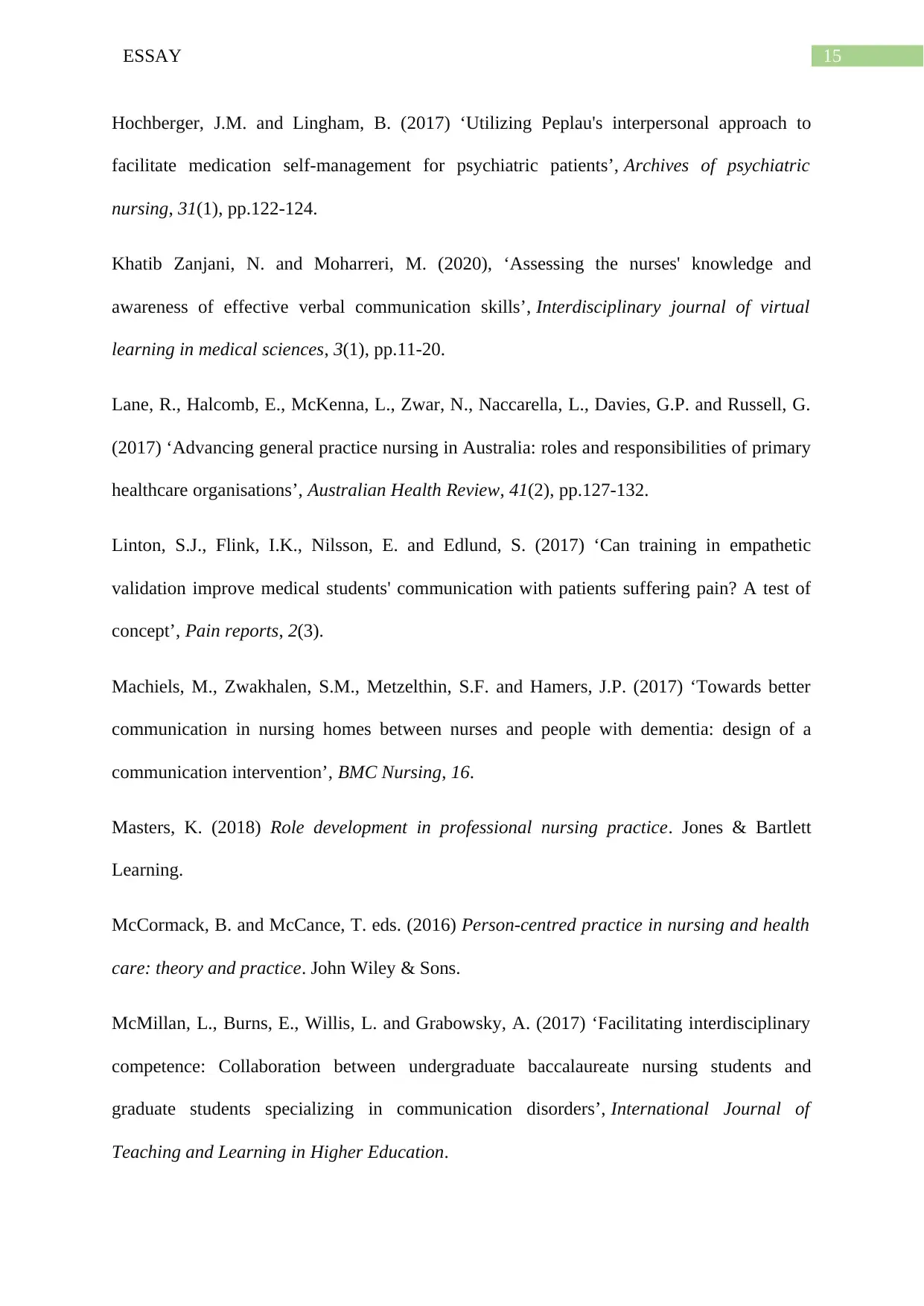
15ESSAY
Hochberger, J.M. and Lingham, B. (2017) ‘Utilizing Peplau's interpersonal approach to
facilitate medication self-management for psychiatric patients’, Archives of psychiatric
nursing, 31(1), pp.122-124.
Khatib Zanjani, N. and Moharreri, M. (2020), ‘Assessing the nurses' knowledge and
awareness of effective verbal communication skills’, Interdisciplinary journal of virtual
learning in medical sciences, 3(1), pp.11-20.
Lane, R., Halcomb, E., McKenna, L., Zwar, N., Naccarella, L., Davies, G.P. and Russell, G.
(2017) ‘Advancing general practice nursing in Australia: roles and responsibilities of primary
healthcare organisations’, Australian Health Review, 41(2), pp.127-132.
Linton, S.J., Flink, I.K., Nilsson, E. and Edlund, S. (2017) ‘Can training in empathetic
validation improve medical students' communication with patients suffering pain? A test of
concept’, Pain reports, 2(3).
Machiels, M., Zwakhalen, S.M., Metzelthin, S.F. and Hamers, J.P. (2017) ‘Towards better
communication in nursing homes between nurses and people with dementia: design of a
communication intervention’, BMC Nursing, 16.
Masters, K. (2018) Role development in professional nursing practice. Jones & Bartlett
Learning.
McCormack, B. and McCance, T. eds. (2016) Person-centred practice in nursing and health
care: theory and practice. John Wiley & Sons.
McMillan, L., Burns, E., Willis, L. and Grabowsky, A. (2017) ‘Facilitating interdisciplinary
competence: Collaboration between undergraduate baccalaureate nursing students and
graduate students specializing in communication disorders’, International Journal of
Teaching and Learning in Higher Education.
Hochberger, J.M. and Lingham, B. (2017) ‘Utilizing Peplau's interpersonal approach to
facilitate medication self-management for psychiatric patients’, Archives of psychiatric
nursing, 31(1), pp.122-124.
Khatib Zanjani, N. and Moharreri, M. (2020), ‘Assessing the nurses' knowledge and
awareness of effective verbal communication skills’, Interdisciplinary journal of virtual
learning in medical sciences, 3(1), pp.11-20.
Lane, R., Halcomb, E., McKenna, L., Zwar, N., Naccarella, L., Davies, G.P. and Russell, G.
(2017) ‘Advancing general practice nursing in Australia: roles and responsibilities of primary
healthcare organisations’, Australian Health Review, 41(2), pp.127-132.
Linton, S.J., Flink, I.K., Nilsson, E. and Edlund, S. (2017) ‘Can training in empathetic
validation improve medical students' communication with patients suffering pain? A test of
concept’, Pain reports, 2(3).
Machiels, M., Zwakhalen, S.M., Metzelthin, S.F. and Hamers, J.P. (2017) ‘Towards better
communication in nursing homes between nurses and people with dementia: design of a
communication intervention’, BMC Nursing, 16.
Masters, K. (2018) Role development in professional nursing practice. Jones & Bartlett
Learning.
McCormack, B. and McCance, T. eds. (2016) Person-centred practice in nursing and health
care: theory and practice. John Wiley & Sons.
McMillan, L., Burns, E., Willis, L. and Grabowsky, A. (2017) ‘Facilitating interdisciplinary
competence: Collaboration between undergraduate baccalaureate nursing students and
graduate students specializing in communication disorders’, International Journal of
Teaching and Learning in Higher Education.
Secure Best Marks with AI Grader
Need help grading? Try our AI Grader for instant feedback on your assignments.
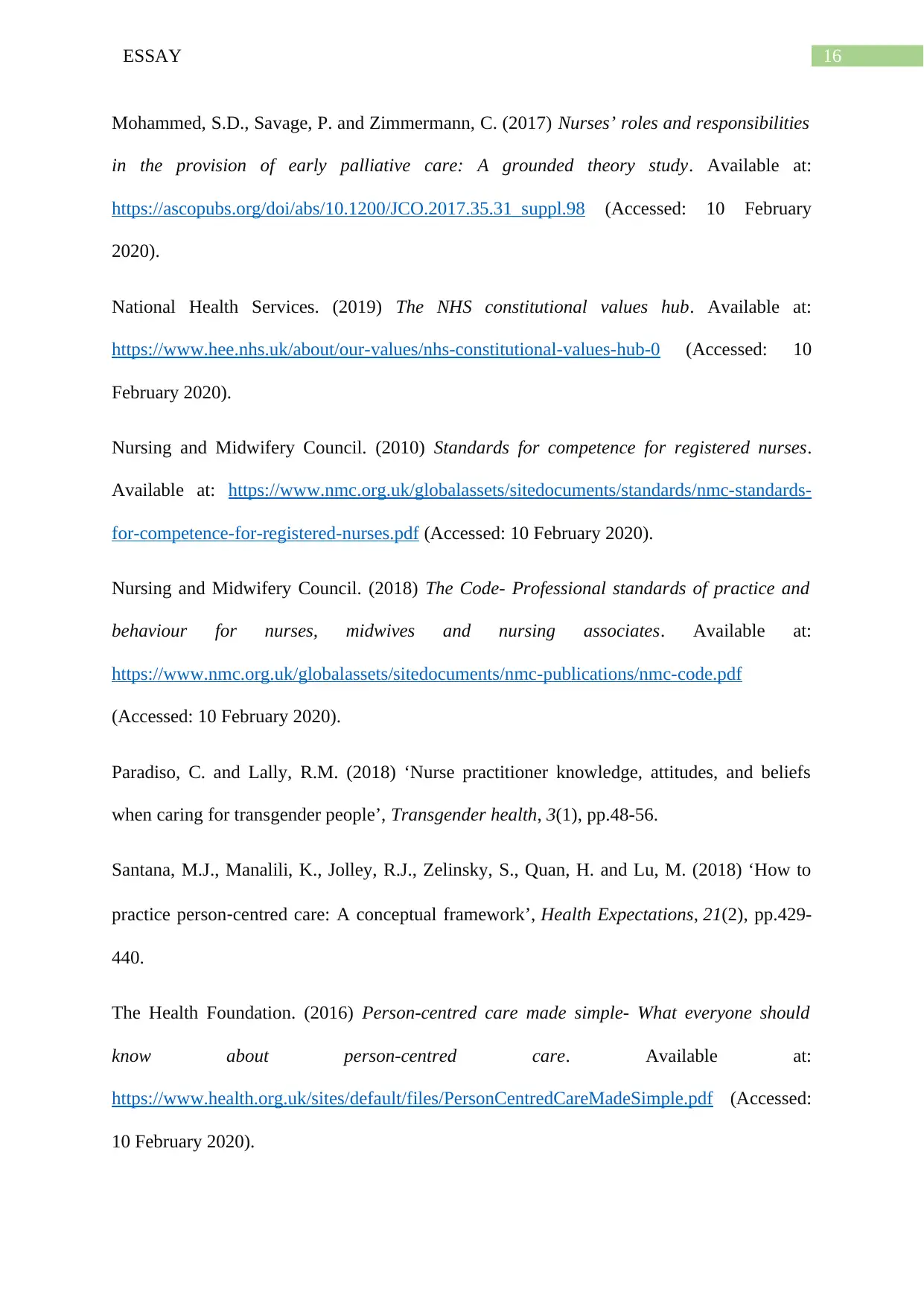
16ESSAY
Mohammed, S.D., Savage, P. and Zimmermann, C. (2017) Nurses’ roles and responsibilities
in the provision of early palliative care: A grounded theory study. Available at:
https://ascopubs.org/doi/abs/10.1200/JCO.2017.35.31_suppl.98 (Accessed: 10 February
2020).
National Health Services. (2019) The NHS constitutional values hub. Available at:
https://www.hee.nhs.uk/about/our-values/nhs-constitutional-values-hub-0 (Accessed: 10
February 2020).
Nursing and Midwifery Council. (2010) Standards for competence for registered nurses.
Available at: https://www.nmc.org.uk/globalassets/sitedocuments/standards/nmc-standards-
for-competence-for-registered-nurses.pdf (Accessed: 10 February 2020).
Nursing and Midwifery Council. (2018) The Code- Professional standards of practice and
behaviour for nurses, midwives and nursing associates. Available at:
https://www.nmc.org.uk/globalassets/sitedocuments/nmc-publications/nmc-code.pdf
(Accessed: 10 February 2020).
Paradiso, C. and Lally, R.M. (2018) ‘Nurse practitioner knowledge, attitudes, and beliefs
when caring for transgender people’, Transgender health, 3(1), pp.48-56.
Santana, M.J., Manalili, K., Jolley, R.J., Zelinsky, S., Quan, H. and Lu, M. (2018) ‘How to
practice person‐centred care: A conceptual framework’, Health Expectations, 21(2), pp.429-
440.
The Health Foundation. (2016) Person-centred care made simple- What everyone should
know about person-centred care. Available at:
https://www.health.org.uk/sites/default/files/PersonCentredCareMadeSimple.pdf (Accessed:
10 February 2020).
Mohammed, S.D., Savage, P. and Zimmermann, C. (2017) Nurses’ roles and responsibilities
in the provision of early palliative care: A grounded theory study. Available at:
https://ascopubs.org/doi/abs/10.1200/JCO.2017.35.31_suppl.98 (Accessed: 10 February
2020).
National Health Services. (2019) The NHS constitutional values hub. Available at:
https://www.hee.nhs.uk/about/our-values/nhs-constitutional-values-hub-0 (Accessed: 10
February 2020).
Nursing and Midwifery Council. (2010) Standards for competence for registered nurses.
Available at: https://www.nmc.org.uk/globalassets/sitedocuments/standards/nmc-standards-
for-competence-for-registered-nurses.pdf (Accessed: 10 February 2020).
Nursing and Midwifery Council. (2018) The Code- Professional standards of practice and
behaviour for nurses, midwives and nursing associates. Available at:
https://www.nmc.org.uk/globalassets/sitedocuments/nmc-publications/nmc-code.pdf
(Accessed: 10 February 2020).
Paradiso, C. and Lally, R.M. (2018) ‘Nurse practitioner knowledge, attitudes, and beliefs
when caring for transgender people’, Transgender health, 3(1), pp.48-56.
Santana, M.J., Manalili, K., Jolley, R.J., Zelinsky, S., Quan, H. and Lu, M. (2018) ‘How to
practice person‐centred care: A conceptual framework’, Health Expectations, 21(2), pp.429-
440.
The Health Foundation. (2016) Person-centred care made simple- What everyone should
know about person-centred care. Available at:
https://www.health.org.uk/sites/default/files/PersonCentredCareMadeSimple.pdf (Accessed:
10 February 2020).
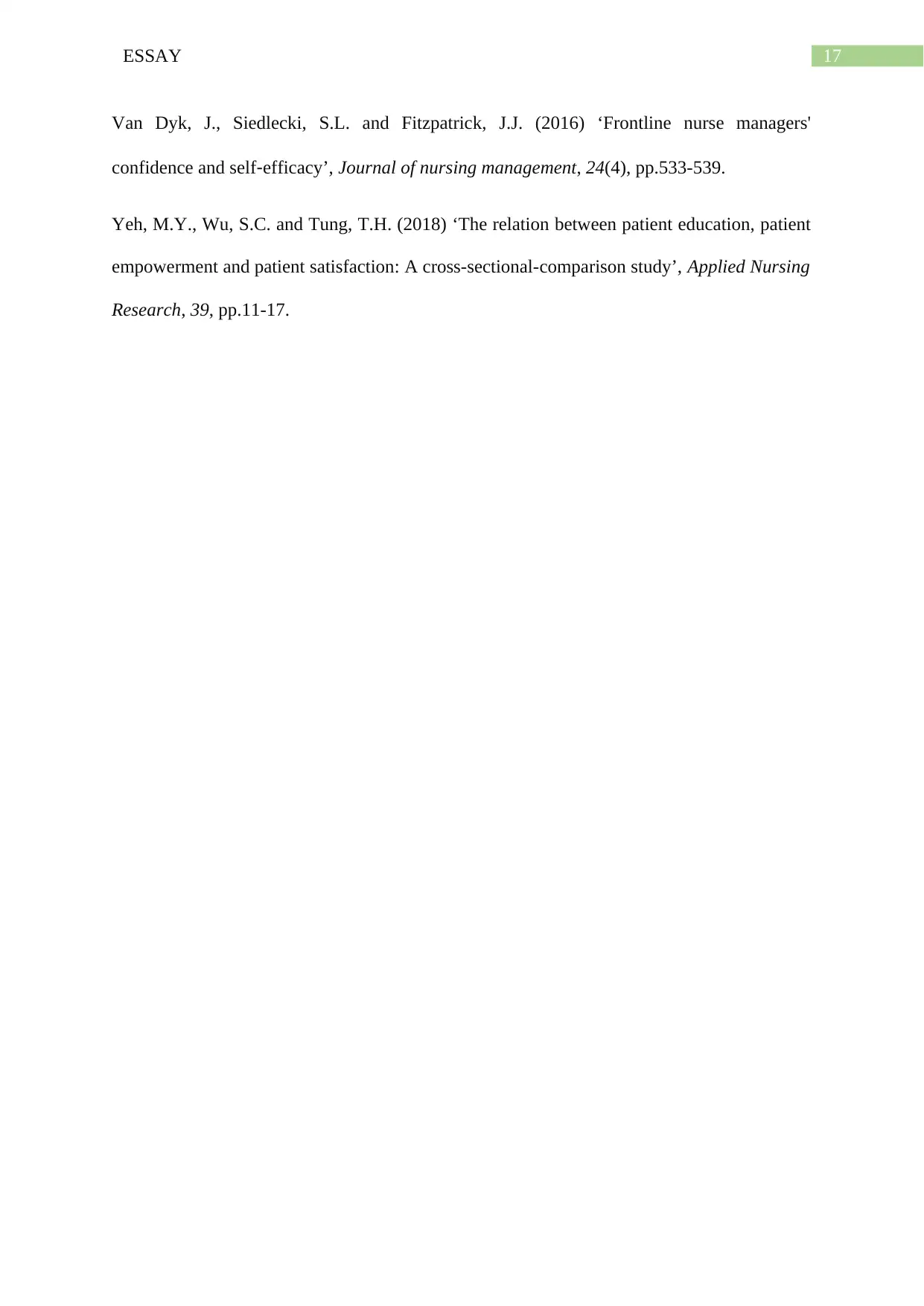
17ESSAY
Van Dyk, J., Siedlecki, S.L. and Fitzpatrick, J.J. (2016) ‘Frontline nurse managers'
confidence and self‐efficacy’, Journal of nursing management, 24(4), pp.533-539.
Yeh, M.Y., Wu, S.C. and Tung, T.H. (2018) ‘The relation between patient education, patient
empowerment and patient satisfaction: A cross-sectional-comparison study’, Applied Nursing
Research, 39, pp.11-17.
Van Dyk, J., Siedlecki, S.L. and Fitzpatrick, J.J. (2016) ‘Frontline nurse managers'
confidence and self‐efficacy’, Journal of nursing management, 24(4), pp.533-539.
Yeh, M.Y., Wu, S.C. and Tung, T.H. (2018) ‘The relation between patient education, patient
empowerment and patient satisfaction: A cross-sectional-comparison study’, Applied Nursing
Research, 39, pp.11-17.
1 out of 18
Related Documents
Your All-in-One AI-Powered Toolkit for Academic Success.
+13062052269
info@desklib.com
Available 24*7 on WhatsApp / Email
![[object Object]](/_next/static/media/star-bottom.7253800d.svg)
Unlock your academic potential
© 2024 | Zucol Services PVT LTD | All rights reserved.





